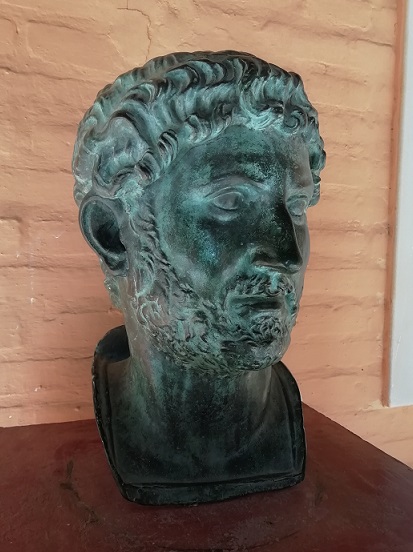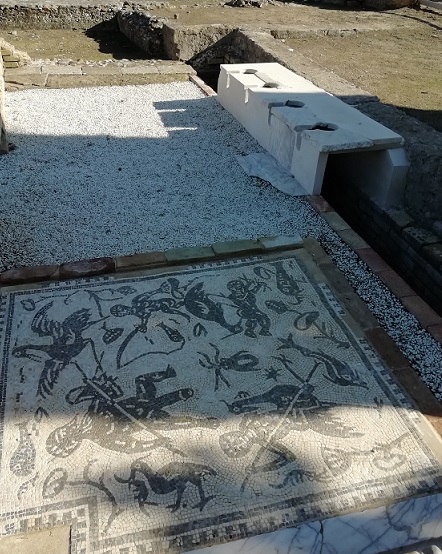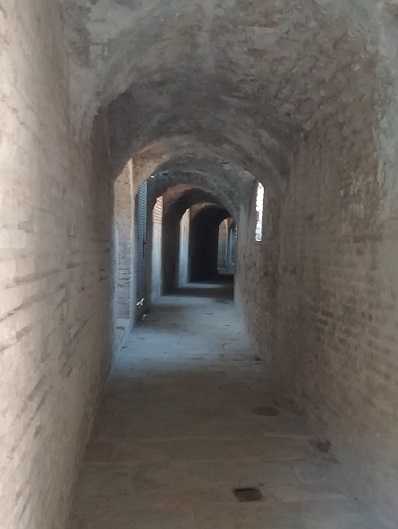The Cap Finistère set out on the 30th of October from Portsmouth to Bilbao without me being on board. An ambulance ride to hospital at the end of August kept me there for a week, and what with further procedures and follow-up appointments, by the end of September, it was looking more and more likely that I would have to cancel – or at least postpone. I had no alternative other than to miss the sailing. So here we are setting out for the Costa del Sol about a month later than usual. For several years now, I’ve booked my outward sailing from Portsmouth quite early in the year, so trying to find a suitable crossing at short notice can often be difficult. It isn’t that the ferries become full, but rather than the basic cabins get booked – leaving only the more expensive luxury cabins available.
So this year my sailing is now on the Baie de Seine which leaves early in the morning. Therefore, I decided to drive down to Portsmouth the previous evening and spend the night on the dock-side. With powerful floodlighting and a Brittany Ferries parking marshal in attendance, it’s possible to spend a safe and peaceful night parked up with others.
Leaving day passed in a whirl. First, there was last minute shopping to get. Then cushions and bedding from the house to caravan. Then food items from house fridge to van fridge. Then finally, time to mover the caravan from its parking spot alongside the house, out onto the drive and hitch on. Lights checked, hitch firmly in position. All ready to start out – after a quick dinner. As I prepared to eat, my emails pinged. Shock horror – it was from Brittany Ferries. Was it possible that after nine years of travelling with them, I was about to experience my first cancellation? Several do during the winter months. I nervously opened the email. Relief – – it wasn’t a cancellation – just a delay – but by 15 hours. So rather than setting off to sleep on the dockside, I took myself off upstairs to bed. I left for Portsmouth in the early evening and arrived at the ferry terminal at 7.30. Instead of one night on board, we were to get two. We were checked through at 9 pm but only as far as security.
In fact, not until half-one in the morning, did I reach my cabin. At 05.30 I needed to ‘take a walk’, and was astounded to see we were still at the berth. However, at half-eight, when I awoke, we were well and truly on our way. This crossing marks my 23rd time I’ve crossed Biscay and it must be one of the roughest. Fortunately – apart from moving about the ship, rough seas don’t worry me. I took this video from the bar window which overlooks the prow of the ship.
https://www.youtube.com/results?search_query=VID+20191127+171919+
Needless to say, the bar was virtually empty.
This isn’t the first time I’ve travelled on the ‘economie’ service and I’ve written about it in previous blogs but for travellers who are new to my website, and may be contemplating using the economie service, here are my views again. The ‘economie’ cabins compare favourably with those on the cruise ferries. Beds and bunks are similar, the en-suite bathrooms are the same, lighting and power sockets are similar. The only difference being that on the ‘economie’ ships, the entry-level cabins have laminate flooring whilst the cruise-ferries have carpet. Because of the postponement, I booked this crossing much later than normal. Therefore I had no option other than to choose a dearer cabin than usual. I must say, it is nice to be able to look out to daylight and sea. Also in spite of my earlier comment – this cabin does have carpet on the floor. On all the ferries, some cabins have two beds whilst others have a bed and an overhead bunk. If like me, you are getting on in years, and you are a couple, you will probably be better off with two beds, rather than a bunk. Getting up and down from a bunk might just require a bit more agility than we are capable of. The lounges and bars are larger on the cruise ferries, with at times some form of entertainment, whilst the ‘economie’ ships settle for smaller bars. Likewise with the shop and restaurant. If you need beauty salons, hairdressers, nail bars, and the cinema, then you’ll need the cruise-ferry. All the ferries have wifi in the main lounges and seating areas. To my mind, it’s usually quicker getting off the smaller ferries, but it really depends upon where you find yourself parked. Finally, the economie ferry shows a saving of between £50 and £100 over the bigger vessels.
The ferry arrived in Santander at 10.30 and having been parked on deck 4, I was quickly called forward for unloading. My passport got a quick glance and with no further vehicle examination, I was heading for the motorway. If one ignores the right turn into the town centre, the road makes its way through the dock installations till eventually, it joins the A67 motorway at a roundabout.
Route planning for this trip started during the early summer when I thought it would be nice to find new places but also to see some towns first visited six or seven years ago, so my drive this year will take me along the A67/A62.
This will be my itinerary – although it’s always subject to change.
And the first change wasn’t long in coming. Sometime before I reached my first stop, the sky had turned black, the rain was beating down and the forecast didn’t indicate any immediate change. So I drove on – finally arriving at Tordesillas. I found the site, on the river bank at the edge of town. I booked in for two nights.
0-0-0-0-0-0-0-0-0-0-0-0-0-0-0-0-0-0-0-0
Camping El Astral is a large site situated alongside a wide and fast-flowing River Duero. The town of Tordesillas is built on a hill and is situated on the far side of the bridge The approach to the site is along an unattractive, potholed, dirt road, leading into an open space in front of the reception building. I entered the office where I was greeted warmly. My passport was copied but my ACSI card was rejected. I booked in for two nights with electricity. I was given a code with which to raise the barrier; also a plan of the site with instructions to park where I wished. I suggested paying immediately and was asked for just €23 – for two nights with electricity!. Although the site runs parallel with the river, it’s not possible to approach the water since a high wire fence surrounds the site and is fixed about 30 yards from the river bank. The toilet block is situated centrally on the site and is fitted out to a very high standard. Laundry sinks are fitted outside the block but under cover. Three pay-to-use washing machines are also installed. Electric bollards are shared by six or so pitches, so a full length mains cable could be required. Water taps are situated at the road sides about 100 meters apart – as are the waste bins. Four foot high hedges separate each plot, many of which are drive through.
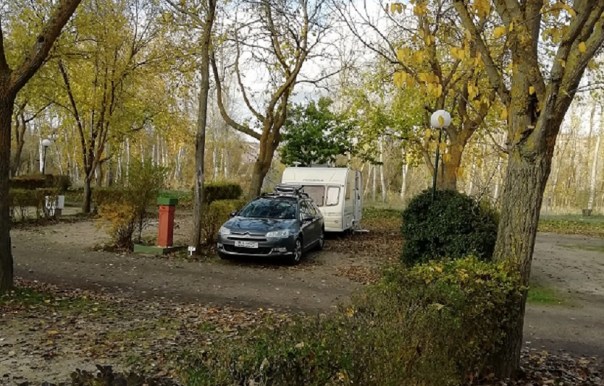
When I arrived, seven other units were also parked. With electric and water connected, I removed a chicken chasseur from my freezer compartment, and after several minutes in the microwave, dinner was ready. I find that well-frozen food from the home freezer, still stays quite solid after the crossing from Portsmouth if the fridge is packed with care. As I prepared for bed, there was that familiar sound again. The rain had caught up with me!
It rained for most of the night and continued into the morning. By ten thirty all my neighbours had packed and moved on. But having booked two nights, I stayed in the caravan taking advantage of the site’s very good internet connection. By lunch time the rain had stopped and the clouds were showing signs of brightening so I got ready to go out and explore. Just a couple of hundred yards along the river bank is the bridge crossing over into town.

It’s known that there was a bridge here in the 10th Century, however the present bridge which is built on ten pointed arches dates from the 16th Century with further repairs being carried out at later periods. Because the river is wide and fast-flowing, repair work is even now being undertaken. On the far side of the bridge, at the entrance to the town is a monument – the Toro de la Vega.
 I drove up the hill, through the old part of the town and arrived at the Plaza Mayor, a typical Castillian square surrounded by arcaded houses and big balconies.
I drove up the hill, through the old part of the town and arrived at the Plaza Mayor, a typical Castillian square surrounded by arcaded houses and big balconies.

The surface is cobbled using two types of stone forming a pattern of squares. A road runs from each side of the square to where once was an outer wall, pierced with entrance gates for each of the four sides. In medieval times, the square would have been used for markets, festivities, bull-fights and religious processions. On all four sides of the square there are colonnaded walk-ways supporting the upper floors of the buildings and their balconies.
I took one of the four roads leading from the square and eventually arrived at the Real Monasterio de Santa Clara. The building was originally built as a palace by Alfonso XI in 1340 but after Alfonso’s death, his son, Peter gave it to his daughter who turned it into a monastery in memory of Santa Clara who had previously founded a Franciscan order of women known as Poor Clares. Wandering about the grounds and buildings, one is reminded of the Alhambra at Granada.
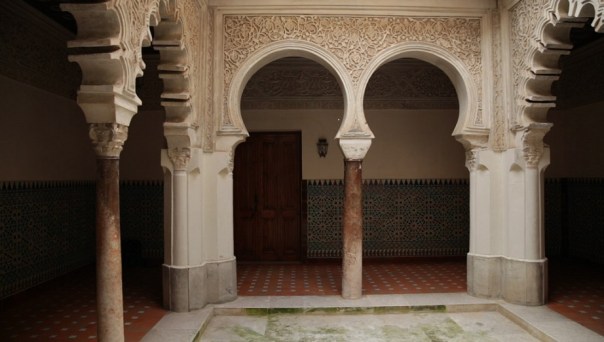
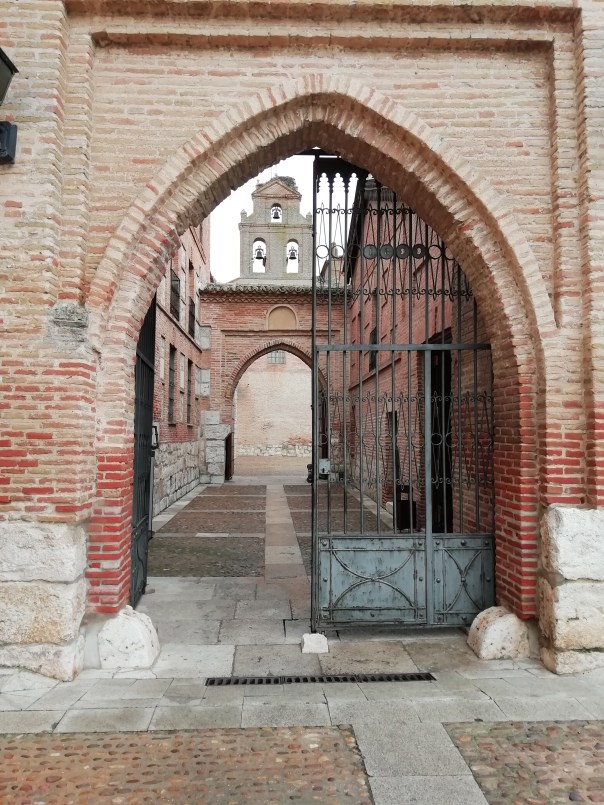


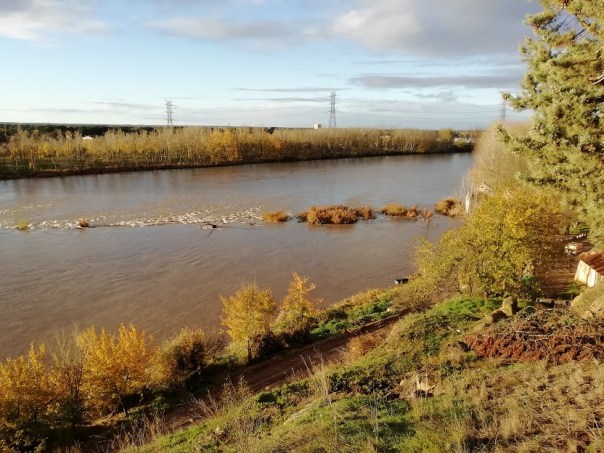
The weather had been kind for four hours but it was too good to last. On the walk back to the Plaza, the rain started again. Time to move on tomorrow.
Saturday.
The sun was shining this morning . First time I’ve seen it since I arrived in Spain. In spite of a neighbour who wanted to talk, I had everything packed and ready to roll by 9.45. The drive to the motorway was along straight, traffic-free roads and within four miles, I was heading south towards Salamanca. By now, the sun had left us and the clouds were taking on an unpleasant shade of black. A few more miles rolled by and I became aware of a headwind with the bushes along the central reservation tossing their heads and leaning towards me. And it wasn’t long before the rain started again. Together with an ever increasing altitude showing on the dashboard, my fuel gauge was falling rapidly. I’ddone 160 miles but still had another fifty miles to do before reaching my planned stop, but then I saw the turn for Caceres, I decided to call it a day and booked in at Camping Caceres.
I’ve been here before so I knew I would not be disappointed. I presented my ACSI card, booked in for two nights and paid €36. The last time I was here was in beautiful weather, under cloudless skies. The site is situated on a slope but every pitch has been levelled. To one side of every plot there is a brick and tiled roofed building. These rooms are practically tiled on floor and walls and each contains a hand basin, toilet pan and shower. The hot water is supplied by instant heaters, so is always available. Each pitch is also supplied with a three metre hose connection, a plastic table and a couple of plastic chairs. Each plot has its own electrical socket. Not many caravanners were on site, so I had a wide choice of pitch. I was fortunate in that I got legs down, water plumbed in and electric connected in the dry, for not long afterwards, the rain returned and persisted throughout the night.
Sunday.
I didn’t need to raise the blinds to see the day. I could hear it. When I did raise them I was greeted by a grim view.

It looked as though it was to be another ‘in’ day. But then the weather forecast for the district was showing some sunshine between 12 and 3, followed by thunderstorms. On the strength of the forecast, I had an early lunch, then set out for the town – which is about two miles away. I’d already noted down the coordinates for a multi-floored car park close to the historic quarter. Being Sunday, I found a slot on the ground floor. I walked through narrow streets and down flights of steps towards the Plaza Mayor hardly believing what I was seeing. The sun was beginning to shine. By the time I’d reached the square, the sky had taken on a completely different aspect – providing I didn’t look behind me!

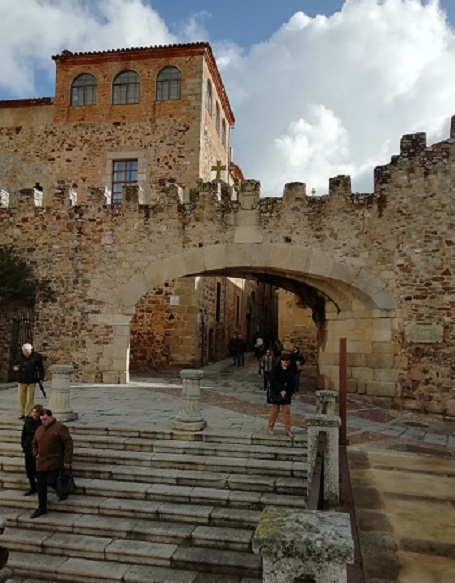
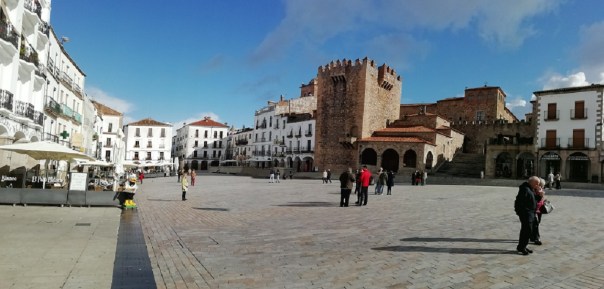 I walked across the square, up the steps and through the Arco de la Estrella to the square containing the Church of Santa Maria. As I stood looking across at the Episcopal Palace, then up at the bell-tower of the church, I was reminded of the passage of time. When I was here last in 2015, I’d thought nothing of climbing up the belfry to see the view from the top. Now, sadly, the first dozen of those steps would leave me struggling to breathe.
I walked across the square, up the steps and through the Arco de la Estrella to the square containing the Church of Santa Maria. As I stood looking across at the Episcopal Palace, then up at the bell-tower of the church, I was reminded of the passage of time. When I was here last in 2015, I’d thought nothing of climbing up the belfry to see the view from the top. Now, sadly, the first dozen of those steps would leave me struggling to breathe.
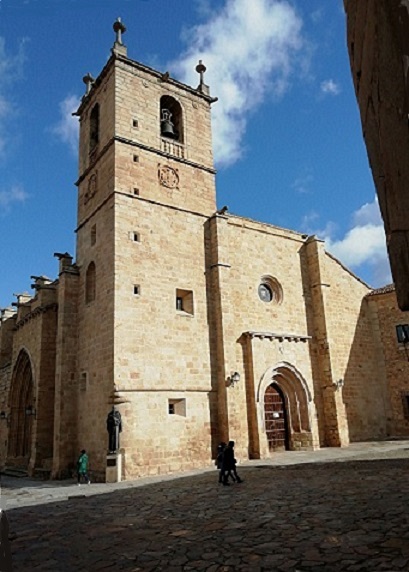
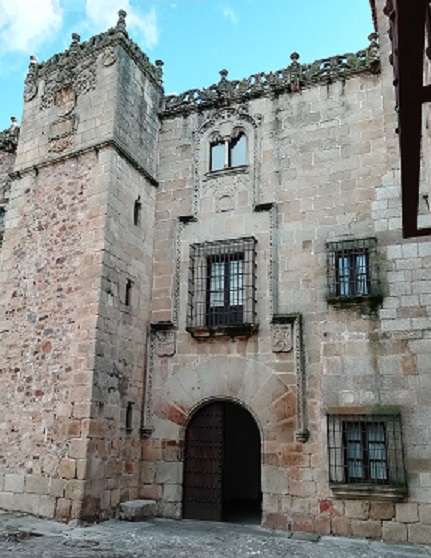
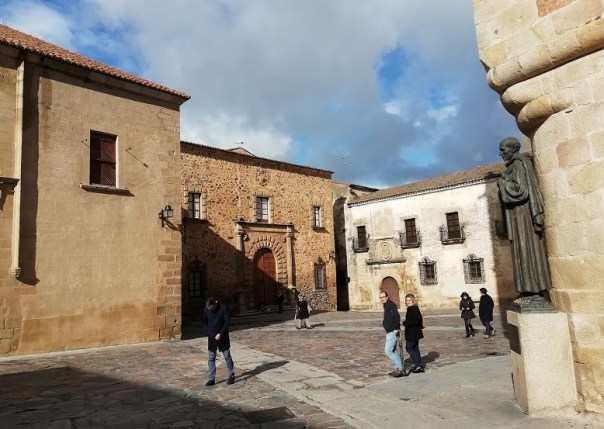
I made my way back through the narrow streets and discovered that since my last visit, an escalator had been fitted alongside one flight of steps. What a welcome sight! Back in the car park, and I presented my ticket to the machine. A very reasonable 85 cents. I suppose it was too good to last. By the time I was back at the site, the rain had returned. Also another caravanner had arrived at this virtually empty site. What made him want to park outside my front window?

Tomorrow is moving day again………And the weather is supposed to be changing… .for the better……….We’ll see!
0-0-0-0-0-0-0-0-0-0-0-0-0-0-0-0-0–0-0-0-0
Monday.
Yes! There was a definite improvement in the weather. At least the rain had stopped. I only had 50miles to do to reach Merida – my next planned stop, so there was no great hurry to leave Caceres.

In fact, it was nearly 11 oclock before I departed and headed north for a few miles to reach the nearest motorway junction. An hour & 10 mins later, I arrived at Camping Merida. Reception was closed, with a notice in the window to the effect that I should find a pitch and return to reception at 18.00hrs.
After some lunch, I took a walk around the site. It’s situated two or three miles outside the town, on a main road leading to the A5 motorway. During the winter, much of the site is cordoned off, confining winter travellers to one side of the central roadway. Pitches are defined by rows of mature trees, with two pitches being back to back. There is one toilet block which is modern, clean and tidy. Water taps are spaced along the central roadway, with an electrical supply fitted at the end of each avenue of pitches – so a full length cable might be required.
Later in the afternoon I drove to the local Mercadona to stock up on a few supplies. If the forecast for tomorrow is correct, we should be in for a good day.
Tuesday.
On the strength of the forecast, I got up early because I’d planned a busy day, so was ready to leave the site by 8.45. I took the road out of town, across the motorway and up into the hills. After six miles I’d reached the Prospero Reservoir, first created by the Romans to supply their city, Emerita Augusta with a water supply.

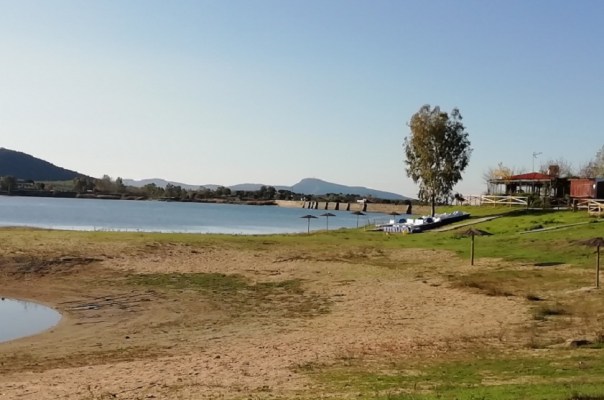
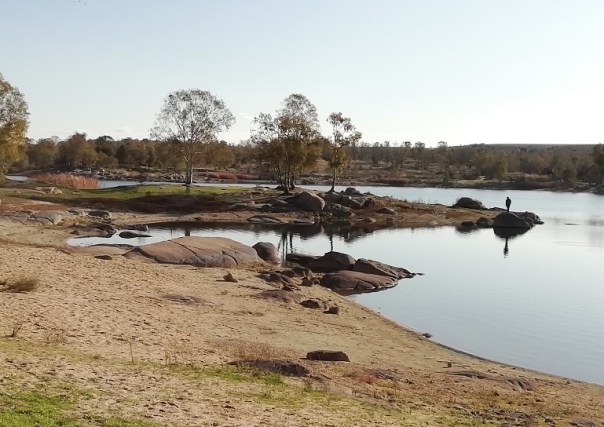 The dam is constructed of stone blocks supported by an earthen wall, then buttressed on both sides. It’s 425 metres long and 21 meters high.
The dam is constructed of stone blocks supported by an earthen wall, then buttressed on both sides. It’s 425 metres long and 21 meters high.

Water from the reservoir was carried in ducts with a fall of one metre in two kilometres so water never flowed faster that 150 litres per second. The water arrived in the town over the Aqueduct Los Milagros, which was next on my places to see.
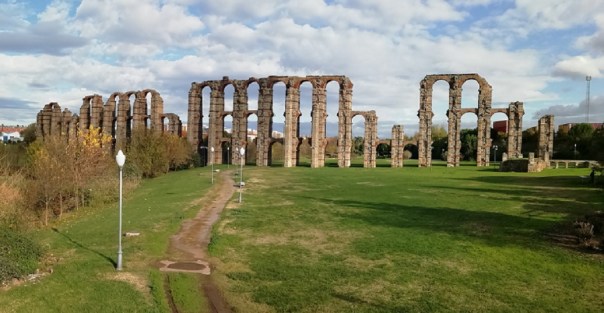
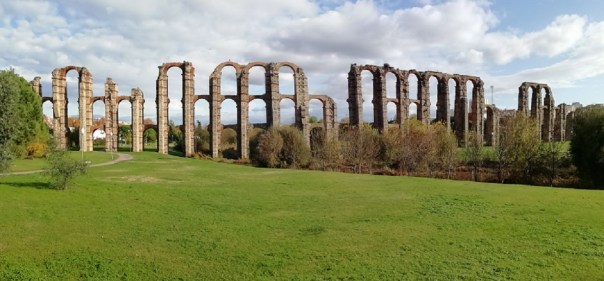
Back in the car, I drove into town. I found a parking slot close to the river, but what now? Do I walk – which I don’t find easy these days – or do I unload the bike and take my chance with speeding traffic along very narrow streets. I decided to walk. The first stretch was to the Alcazar, built by the Arab invaders in the 8th Century on the site of a Roman gateway and fort..

I bought my ticket which also gives entry to all the other places of interest. From the top of the walls there are some beautiful views across the river.
 In the foreground is the Roman Bridge which was built to carry the Roman road from the south to the north of the Iberian peninsular. The bridge was first erected in 25BC and because the river is wide and susceptible to flooding, it is built on huge rectangular blocks with 60 arches. Midway across the river, the Romans built a huge island on which to carry some of the roadway. Because of the width of the river, the bridge is the longest existing Roman bridge throughout what was the old Roman Empire.
In the foreground is the Roman Bridge which was built to carry the Roman road from the south to the north of the Iberian peninsular. The bridge was first erected in 25BC and because the river is wide and susceptible to flooding, it is built on huge rectangular blocks with 60 arches. Midway across the river, the Romans built a huge island on which to carry some of the roadway. Because of the width of the river, the bridge is the longest existing Roman bridge throughout what was the old Roman Empire.
From the Alcazar I took a road slightly up hill, arriving at the Temple of Diana. Not until the 17th Century was it given that name.

We now know that the temple was built in honour of the Emperor Augustus since many artifacts relating to him and his family have been found here.
Just a 100 yards or so up the road is the Forum Portico.
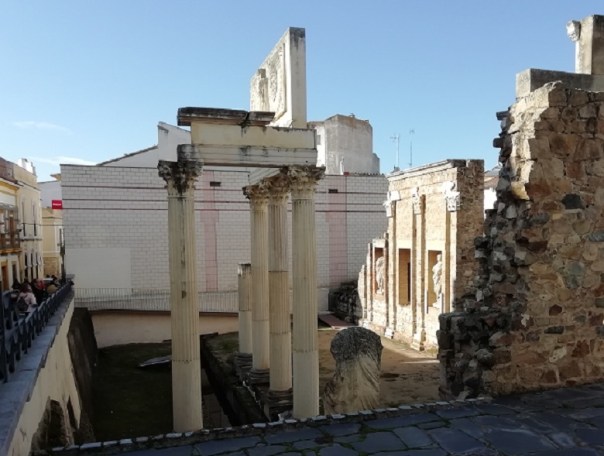 It was built around the middle of the 1st century in the image of the Augustus Forum in Rome.
It was built around the middle of the 1st century in the image of the Augustus Forum in Rome.

Close by is the Trajan Arch, one of the original entrances to their town.
Finally, a few streets away is the complex containing the arena and theatre. Most arenas of the Roman period are built to a standard plan. Only the size of the arena changes, according to the status of the town.
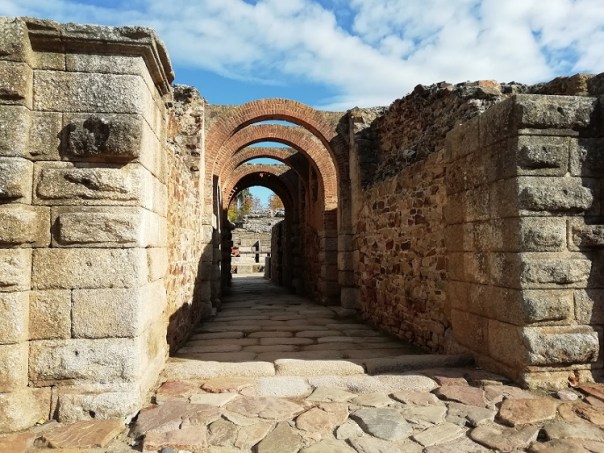
 Oval in shape with tiered seating, and the floor of the arena being sanded with the central area covered with removable wooden planks. Below the floor were cells where gladiators and animals awaited their turn to become part of the performance. This one has been dated to the 8th C BC and was constructed to seat around 15000 people.
Oval in shape with tiered seating, and the floor of the arena being sanded with the central area covered with removable wooden planks. Below the floor were cells where gladiators and animals awaited their turn to become part of the performance. This one has been dated to the 8th C BC and was constructed to seat around 15000 people.
Next door to the Arena is the Roman Theatre built on the orders of Marcus Agrippa, a Roman general and son in law to Caesar Augustus. It had seating for 6000 spectators.

The sun was still shining; a few clouds had rolled in, but I’d had enough. It was back to the car for a very late lunch and a beer. Tomorrow is moving day again……. Camping Villsom at Seville!
0=0=0=0=0=0=0=0=0=0=0=0=0=0=0=0=0=0=0=0
Wednesday.
The drive from Merida to Seville was only 130 miles and since I did it without a break, I arrived at the site in time for an early lunch. Camping Villsom is a wooded site laid out on a red sandy ground, consequently, the sand is easily transferred from shoes to car or caravan
It does, however, drain quickly after rain. There’s only the one toilet block to one side of the site which has obviously been refurbished to a quite high standard. The electric bollards are situated in the centre of the site, so some pitches will require an extra-long mains lead. The water points are very decoratively tiled illustrating the adventures of Don Quixote.
However, without a useful length of hose, the taps are not Aquaroll friendly. The last time I was here – around five years ago, the site was without lights at night-time. Street lighting has now been installed. Camping Villsom seems to be the only site open in the winter months, consequently, there is no ACSI discount and it is the most expensive site I’ve used on this present tour. For one person with a car and caravan+electric the fee was €39.50 for two nights.
With water and electric connected, and a nice sunny afternoon ahead of me, I decided to drive back up the motorway for 16 miles to take a look at Italica. This is a large area where the Roman City of Italica once stood. For others wishing to visit this attraction it’s worth mentioning the fact that like most archaeological sites in Spain, the complex is closed on Mondays. Admission price is a modest €1.50, however I presented my EU passport, so I entered without charge. The modern town of Santiponce is built on just part of the ruins, so much of the excavations are in an area which has never been developed. The port and city of Italica was founded around 200 years BC and was the first Roman settlement to be built in the south of the Iberian Peninsular. It began life as a settlement for soldiers who had been wounded in battle against the Carthaginian Armies
Hadrian spent his childhood here whilst Trajan, another future Emperor was born in the city. When Hadrian became emperor much of the town was rebuilt with new temples and public buildings. Although the house walls have long gone, the mosaic floors are left.
Wide streets were laid out in a grid pattern which were paved.
Curb stones gave a raised porticoed pavement along each side. Under the main streets is a system of arched drains to carry away household sewage.
Also the town benefited from public toilets.
A water supply was brought to the city in aqueducts where it was stored in cisterns. Lead pipes fed water to various fountains and public bathhouses in the town.
Just outside the city walls was the amphitheatre. The one built at Italica had seats for 25000 spectators, making it almost as big as the Coliseum in Rome.
The arena floor had a basement beneath it which housed animals and other equipment used in the activities.
The city’s demise began from the 3rd century when the Guadalquivir river changed its course, leaving the city’s docking area silted up. At the same time, the new, nearby city of Seville began to gather importance.
Thursday.
I had a long day planned so I made an early start by leaving the site by 8.40. I joined the commuter traffic heading up the motorway into the city centre. I found car parking impossible so I briefly parked illegally and went the 100 yards or so to grab a couple of pictures of the Plaza de Espania.
The complex was built in 1928/29 as part of the Spanish/American Exhibition. Unfortunately, the function wasn’t quite the success it had been hoped for because the financial depression in America coincided with the opening of the exhibition. With my pictures taken, I hurried back to the car and decided to head back to the motorway. This time the A4 for my next stop 25 miles away at the town of Carmona. I found a parking slot in a street close to the Alcazar. Being 11am, it was just about to open. The castle was started in the 7th Century as a Palace for the Islamic Governor of the district. It was extended and improved in the 14th Century by King Pedro 1st. Later still at the end of the 15th Century it was used by Ferdinand & Isabella. Being situated on the highest point, there is a wonderful view from the tower walls.
Knowing that it might be difficult to park, I decided to walk to some of the other buildings of interest. A few streets away I visited the Santa Clara Convent. The community was created in 1460 with one of the main benefactors being Beatriz, the Duchess of Arcos, the same benefactor that supported the convent at Tordillas. In present times, the nuns’ workshop specializes in the production of pastries.
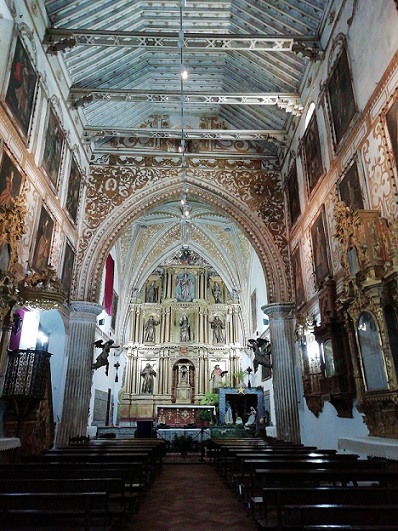
From the convent I moved on a couple of streets and called in at the town museum where several rooms are given over to different periods throughout the ages. For a town that attracts visitors from all over the world, it’s a pity that descriptive notes are confined to just Spanish text. A few hundred yards down the road brought me to the Puerta de Córdoba, a huge triumphal arch built as one of four entrances to the town during the Roman period.
Over the years the appearance has changed with modifications being carried out. Originally it was built with a three-arched entry but later, the two outer arches were built up. From this point, I turned about, walked the length of what used to be the Roman high street and arrived at the second entrance to the town, the Puerta de Sevilla. Although this is the site of the Roman entrance to the town, the building is from the Moorish times when the Alcazar was also built. It underwent major alterations in the 14th and 15th centuries.
It was at this point that I realized I hadn’t a clue how to get back to where I’d parked the car. I walked backwards and forwards trying to find streets that I thought would take me in the direction I needed to go. But to no avail. Eventually I decided I would have to return along the route taken from Puerta de Córdoba. I stopped once again to rest in the Plaza de San Fernando.
By following signs to the Museum and thence to the Convent, I began to recognize roads I’d walked along earlier in the day. One final bench on which to rest and I knew I would find the car just around the corner. Gratefully, I got in to have a late lunch. The time – just coming up to 4pm.
I’d had all the walking I needed for one day so just one more stop before heading for the motorway. This next one could be seen from the roadside – the undeveloped site of the town’s Roman Arena.
Tomorrow is moving day again.
0-0-0-0-0-0-0-0-0-0-0-0-0-0-0-0-0-0-0-0
Friday.
Only ninety miles to do before reaching Camping Sierracillia however, I left Villsom at Seville at 9.15. I wanted to be there before lunch so that I could get out sight-seeing during the afternoon. Google maps suggested the first few miles cross–country but it showed no less than 22 junctions or roundabouts in the first nine miles.. I opted for the long way round, doing an extra six miles via the A4 up to Seville, then the ring road to the A92. Having programmed Tomtom with the GPS coordinates, the device guided me directly to the wide entrance at Camping La Sierracillia. Just inside the gates was a huge carpark – which was just as well, because there were six cars and caravans already parked there. Then I saw the queue at reception – at least twenty people waiting. I joined them. And eventually, after at least thirty minutes wait, reception told me “I am sorry, we have no space. It is the Bank Holiday”. Of course! It was the 6th & 8th of December. He then told me of another site in the next village – to which I went. But even there I was asked if I had a booking, and then was turned away. No doubt the reason for the popularity is that both sites are very close to Fuente de Piedra, a popular nature reserve with a lagoon which is a breeding ground for flamingos.
So what next? I’d already heard that my pitch at El Pino was ready and waiting, so probably best to drive another 75 miles and arrive early at Torrox. A quick stop for lunch then down the A45 to Malaga, then along the A7. I was there by four and gave them a surprise. A quick check on the site confirmed my usual pitch was empty, then to the cash-point to draw sufficient funds to pay for the first month. Exactly the same cost as last year. Check in completed; I drove into the site; engaged the mover and maneuvered the van into position – avoiding the trees. With water and electricity connected, not much else was done that day – other than greet old friends from previous years. Ormond, a Norwegian guy was as usual, across the road from me. Two Dutch and a German couple were on their pitches up on the next level behind me. And a French couple who are nodding acquaintances from previous years is on the pitch next to me. Other than the French on the next pitch, all the other neighbours speak excellent English.
By 9am the following morning I’d made a start unpacking the awning, pole bag and various boxes from the car. I carry a roll of thin plastic membrane 24” wide. When a five-metre length is cut from it, it opens out into an under-sheet which fits nicely under the awning matting. When the matting is lifted in February, it’s relatively clean and the plastic sheet is dumped – or hopefully, recycled! I’d no sooner got that done when Willy, Paul, Rob, and Alan all arrived and made short work of erecting the awning for me. How kind was that? I was very grateful. A leisurely afternoon was spent on my own arranging my kitchen range, installing lighting and seating and putting up some Christmas lights.
And then, next morning, how wonderful, at 10 o’clock to roll down the front of the awning, take a coffee with me, then sit and watch the sun come up over the hill.

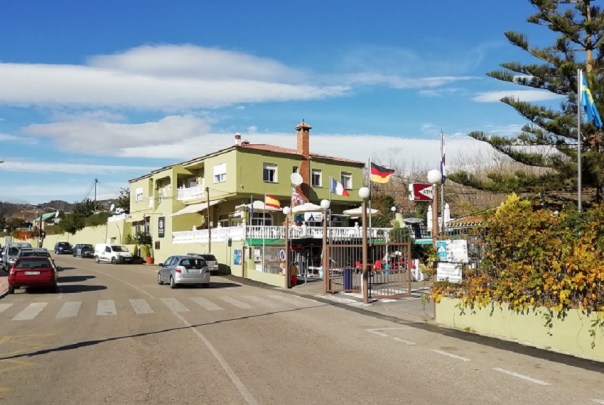
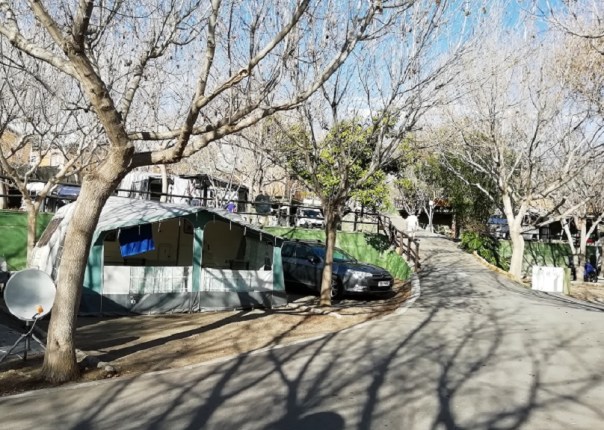
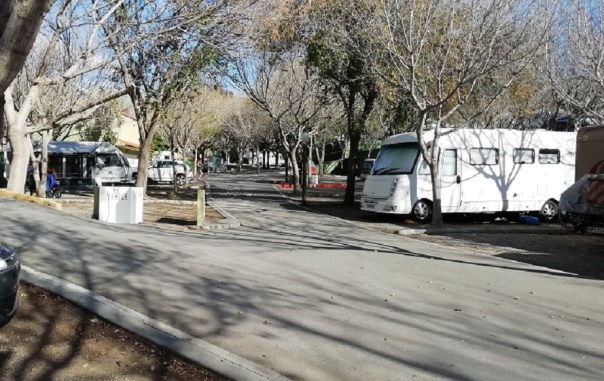
Some pictures of the site at El Pino.
0-0-0-0-0-0-0-0-0-0-0-0-0-0-0-0-0-0-0-0
The usual good weather had suddenly deserted us when we got a couple of days of dark skies and almost constant rain. But the forecast insisted that by Sunday the weather would be back to normal. And it was. Sunday broke without a cloud in the sky and very soon the sun was coming up. Which was just as well, because today was the date set for the Migas Festival in Torrox Pueblo – the last Sunday before Christmas Day. The Spanish are never wanting for an excuse to hold a street party, and this one commemorates times past when most country folk worked on the land, tending the vineyards, orange and olive groves. They worked from day-break to sunset with a break for siesta at mid-day. Labourers working on the large estates would be waiting t hear at mid-day the sound of a horn, traditionally blown on a conche shell.

Then they would return to the estate buildings where a meal of Migas would have been prepared. The migas was served with bread and wine. It was prepared in a huge flat-bottomed pan over a wood fire. Into the pan went olive oil, water, stale bread crumbs, garlic, any available shell fish, diced chicken, pieces of bacon and sliced sausage. Today, the migas is prepared using olive oil, flour and spices and is served with a salad. From early morning teams of volunteers get to work setting up wood fires in the car park on the edge of town.
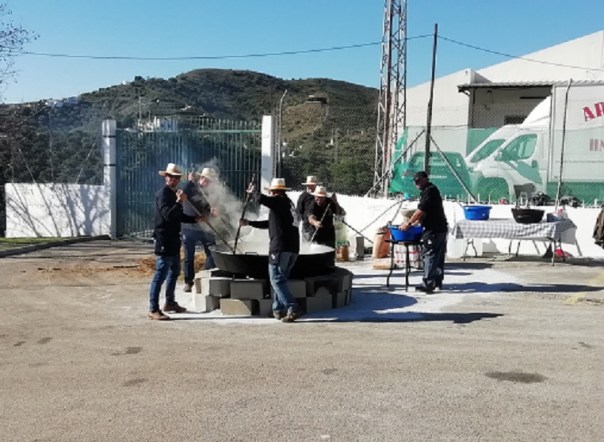 By 12.30 the teams are ready to start serving the long queues of visitors to the Festival.
By 12.30 the teams are ready to start serving the long queues of visitors to the Festival.
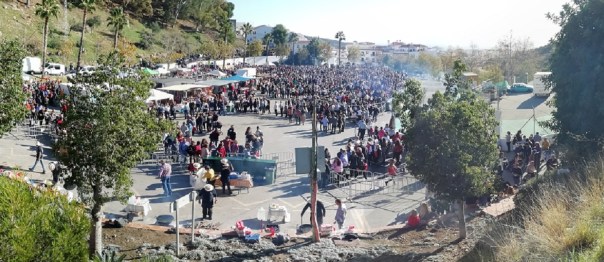 Every visitor is welcome to receive a plate filled with the migas together with a side-salad.
Every visitor is welcome to receive a plate filled with the migas together with a side-salad.
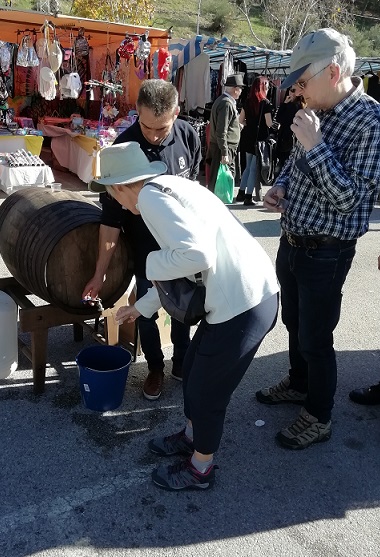
 Situated around the park are barrels of wine where visitors are free to take a cup and drink their fill.
Situated around the park are barrels of wine where visitors are free to take a cup and drink their fill.
Also in the carpark are stalls set up by various local producers of pastries, cheeses, wines, sausages, nuts and barbecued ham sandwiches and sausage rolls.


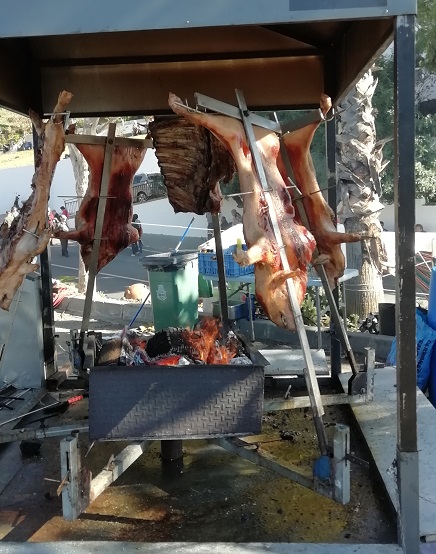
 Meanwhile, in the main plaza a stage had been set up where throughout the day teams of dancers and bands put on performances with some groups continuing their performance through the main streets.
Meanwhile, in the main plaza a stage had been set up where throughout the day teams of dancers and bands put on performances with some groups continuing their performance through the main streets.
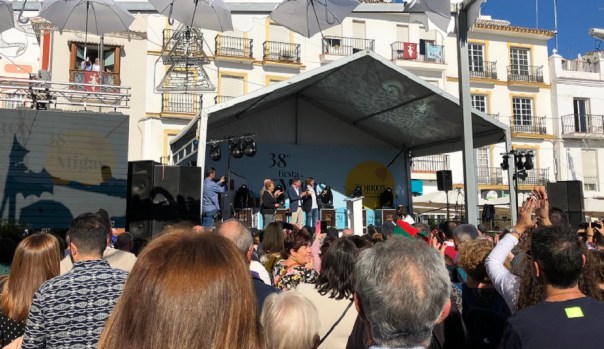
The partying goes on long into the night.
0-0-0-0-0-0-0-0-0-0-0-0-0-0-0-0-0-0-0-0
Many outfits on the site have been decorated with Christmas lights.



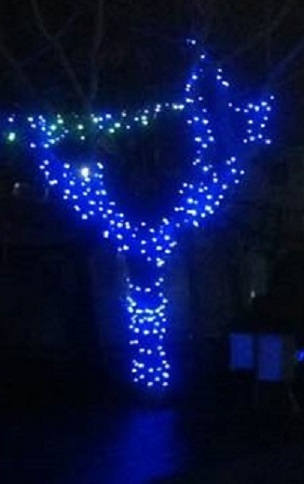

0-0-0-0-0-0-0-0-0-0-0-0-0-0-0-0-0-0-0
On Saturday my daughter, Jen arrived at Malaga Airport for a week’s stay over the Christmas period. She booked online for an apartment not too far from the site – an apartment which was identical to the one both daughters used three Christmases ago – identical because the two apartments happened to be next door to one another.
Having given her time to get settled, I later returned to her apartment, collected her and we drove into Nerja for dinner at one of our favourite restaurants —The Mirasol. It was good to go there again, and good to see their prices haven’t increased significantly since last year. Two chicken breast fillets, chips and salad with a beer for me, and pork sirloin with chips and vegetables and white wine for her all for around €18.
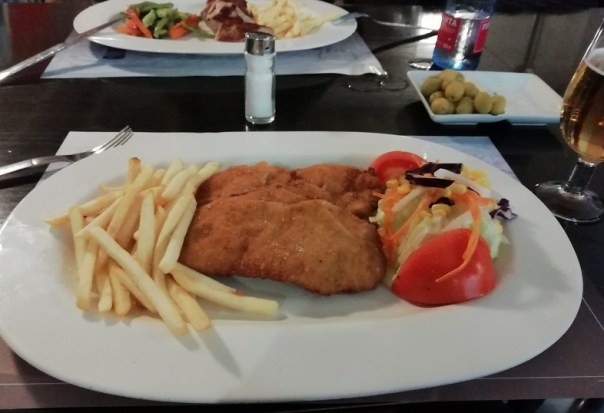
0-0-0-0-0-0-0-0-0-0-0-0-0-0-0-0-0-0-0
A beautiful morning on Sunday so Jen walked up to the campsite for coffee, then we took the short drive up the valley into the hills to take a look at Lake Viñuela.

 It isn’t really a lake but a man-made reservoir formed by the building of a dam across the river. It’s the largest of several reservoirs supplying water to the region. When the reservoir is full it is supposed to hold 170million cubic metres of water but the present estimate is that it’s only a 1/3 full. Each year, the level of the water appears to be lower than when last seen. Maybe that’s due to the fact that the number of giant plastic greenhouses is forever increasing.
It isn’t really a lake but a man-made reservoir formed by the building of a dam across the river. It’s the largest of several reservoirs supplying water to the region. When the reservoir is full it is supposed to hold 170million cubic metres of water but the present estimate is that it’s only a 1/3 full. Each year, the level of the water appears to be lower than when last seen. Maybe that’s due to the fact that the number of giant plastic greenhouses is forever increasing.
Later we drove to the beach at Torre del Mar and set up our sun loungers for a picnic lunch.

0-0-0-0-0-0-0-0-0-0-0-0-0-0-0-0-0-0-0-0
Monday
We set off from Torrox driving east along the old coast road. As the road snakes its way up and over and around headlands, the new motorway takes a more direct route higher up the hills through cuttings, across viaducts and through tunnels. Where road improvements have been made on the coast road, often the old part of the road has been left as a lay-by. They make great spots to stop to admire the view.

 Eventually we arrived at Herradura where we were able to park on the beach and set up our chairs. Herradura beach is situated along the back of a horseshoe-shaped bay.
Eventually we arrived at Herradura where we were able to park on the beach and set up our chairs. Herradura beach is situated along the back of a horseshoe-shaped bay.

At the end of the afternoon Jen and I persuaded each other to go out for dinner again so this time we decided on another favourite place, the Bamboo Restaurant.

0-0-0-0-0-0-0-0-0-0-0-0-0-0-0-0-0-0-0-0
On Christmas Day I headed off to Jen’s apartment where we opened presents and cards, and did video calls to other family members.
 We’d decided on an evening dinner in the apartment so a picnic lunch was called for. One of the most picturesque local beaches is at Burriana, so it was to there we went. But so had everyone else! There wasn’t a parking slot to be had anywhere. The crowds weren’t there for the beach itself, but for the bars and restaurants which line both sides of the promenade. A quick change of plan was called for, so we headed round to Playazo beach on the other side of town. Not only could we park on the beach, but we found it almost deserted.
We’d decided on an evening dinner in the apartment so a picnic lunch was called for. One of the most picturesque local beaches is at Burriana, so it was to there we went. But so had everyone else! There wasn’t a parking slot to be had anywhere. The crowds weren’t there for the beach itself, but for the bars and restaurants which line both sides of the promenade. A quick change of plan was called for, so we headed round to Playazo beach on the other side of town. Not only could we park on the beach, but we found it almost deserted.
 Following a picnic lunch and a San Miguel, I dozed away the rest of the afternoon, thinking how lucky I was to be able to relax on a beach at the end of December in the warm sunshine.
Following a picnic lunch and a San Miguel, I dozed away the rest of the afternoon, thinking how lucky I was to be able to relax on a beach at the end of December in the warm sunshine.
0-0-0-0-0-0-0-0-0-0-0-0-0-0-0-0-0-0-0-0
Boxing Day.
They don’t have a Boxing Day in Spain – it’s just another working day. That’s not to say they miss out, because they have the 6th January and also the 6th & 8th of December as Bank Holidays. However, we decided to take a drive along the coast and spend some time on the beach at Salobreña. The old town stands on a rocky prominence with steep, narrow streets leading up to a 10th Century Moorish Castle standing on the highest crag. The flat plains below are filled with sugar-cane fields which during the 19th Century was one of the main industries of the region. In and around Torrox are the ruins of three sugar factories. At the centre of the beaches is El Peñón – a huge rock which divides the beach into two. I have explored both the town and the rock on previous visits. Now, I’m happy just to sit and enjoy the sunshine.
At seven in the evening we thought it would be nice to visit the Bamboo again for dinner but it was not to be! They were full! A table could be kept for us at 8pm so we settled for that and spent the hour by strolling along to the Balcon to see the Christmas lights.


0-0-0-0-0-0-0-0-0-0-0-0-0-0-0-0-0-0-0-0
Friday
It’s always a sad day when it’s time for going home, so today I was due at the apartment shortly after ten to do the airport run.. It’s a 45-mile drive to the airport, and we like to make time to have a last coffee at the beach at Torremolinos, followed by a short stroll along the prom. And then the drive from the beach to the airport can be done in less than 10 minutes.
As I sat at the beach at Torremolinos I took in the view of the mountains just inland and recalled the journey we did a few years ago to the top of Mount Calamorro. I made up my mind to drive from the airport across to Benalmadena and ride the Teleférico. Having bought my ticket, I queued for a while awaiting my turn for a cabin. Having boarded, the cabin at first rocks and sways, then settles into a smooth ride upwards for the next 15 minutes, up to the terminus at the top of the mountain.
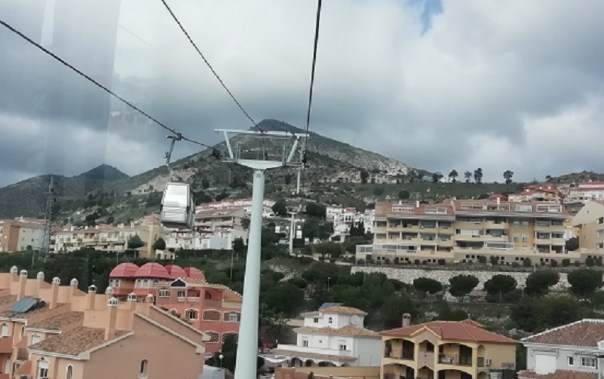 Once there, I headed along to the Falconry centre and was just in time to catch the start of the Birds of Prey show.
Once there, I headed along to the Falconry centre and was just in time to catch the start of the Birds of Prey show.



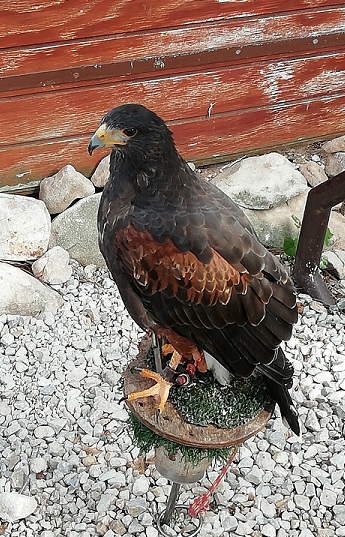
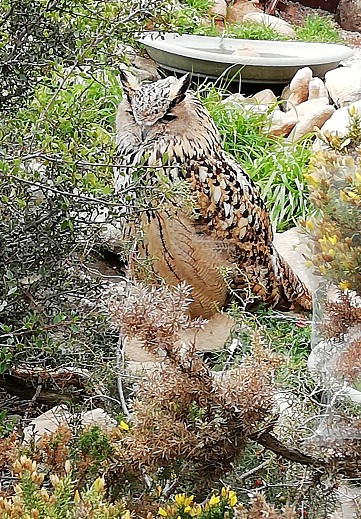
Sadly the weather at the mountain top was not the same as it had been at sea level. The views from the top can be fantastic on good days with the shores of north Africa to the front and to the Sierra Nevada to the rear, but on that day it was cloudy and cold. Once the show was over, I joined some T-shirted and shorts-clad visitors heading downwards to warmer regions.

0-0-0-0-0-0-0-0-0-0-0-0-0-0-0-0-0-0-0-0
No sooner was daughter, Jenny back home after spending Christmas week in Spain, than she was packing to fly out again, together with her sister and partner. This time to help me celebrate my birthday. They don’t normally come for the 6th of January but as this one ended in a nought, they considered it special. In fact it was my 90th. So on Saturday, I headed along the A7 to Malaga Airport to collect them. Although they were to be here for only three nights, they had been able to book the same lovely apartment they rented for Christmas Week in 2018.

Having left them to settle in, I returned at 7pm so that we could drive to Nerja for dinner at Mirasol.
0-0-0-0-0-0-0-0-0-0-0-0-0-0-0-0-0-0-0-0
Sunday was a lovely day with just a few white, fleecy clouds. Both girls like walking, so we did the short drive up the hills to the closest of the White Villages – Frigiliana.
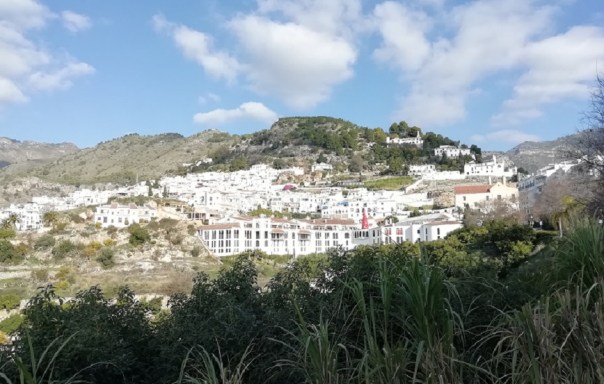 The village is divided into two parts, the older and more picturesque part was built during the Arab occupation of Spain. It’s built on the side of a mountain, so many of the winding, narrow streets are not only steep, but also stepped.
The village is divided into two parts, the older and more picturesque part was built during the Arab occupation of Spain. It’s built on the side of a mountain, so many of the winding, narrow streets are not only steep, but also stepped.
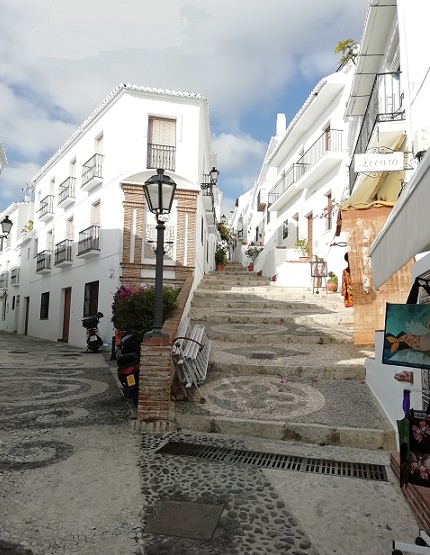
At the top is the site of an Arab Castle, very much ruined after the Moors were driven out in 1569. I drove my visitors to the far end of the village and left them to walk up, and through the lanes, having arranged a meeting point for later in the morning. Meanwhile I parked on the other side of the village and unloaded my bike. Cars are forbidden in the streets however, scooters and bicycles are allowed so I set off through the lanes. The first building I stopped at was the Palacio de los Condes de Frigiliana.
 It was built in the late 16th century for the Manrique de Lara family. The family planted sugar cane plantations and established a sugar mill. From the frontage of the building, there are lovely views across the slopes to the coast.
It was built in the late 16th century for the Manrique de Lara family. The family planted sugar cane plantations and established a sugar mill. From the frontage of the building, there are lovely views across the slopes to the coast.
 Also, there were signs of the beginning of Spring.
Also, there were signs of the beginning of Spring.
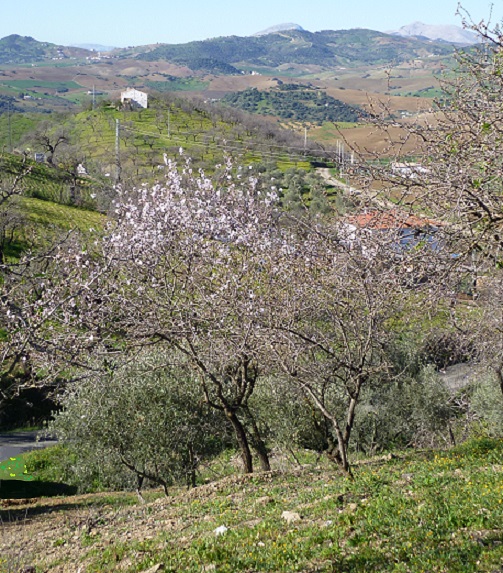
I rode up through the village finally stopping at Plaza de la Iglesia to see the Church of San Antonio de Padua. The inscription on the facade states that it was completed in1676.

After we’d met up back at the car, we drove the few miles down to Burriana Beach where we parked, then carried our chairs and mats to the beach. Burriana is probably the most popular of all the Nerja beaches, the attraction no doubt being the bars and beach-side restaurants.
 After an enjoyable picnic lunch by the sea, I left the visitors and returned to El Pino. The family did the walk back to their apartment via the prom and local beaches. At five, we returned to Nerja not only for dinner but also to celebrate the Fiesta of the Three Kings. Fiestas take place at many towns and villages on the eve of the sixth of January because, for some families, the 6th is the most important day of the Christmas period. We watched the procession forming up,
After an enjoyable picnic lunch by the sea, I left the visitors and returned to El Pino. The family did the walk back to their apartment via the prom and local beaches. At five, we returned to Nerja not only for dinner but also to celebrate the Fiesta of the Three Kings. Fiestas take place at many towns and villages on the eve of the sixth of January because, for some families, the 6th is the most important day of the Christmas period. We watched the procession forming up,

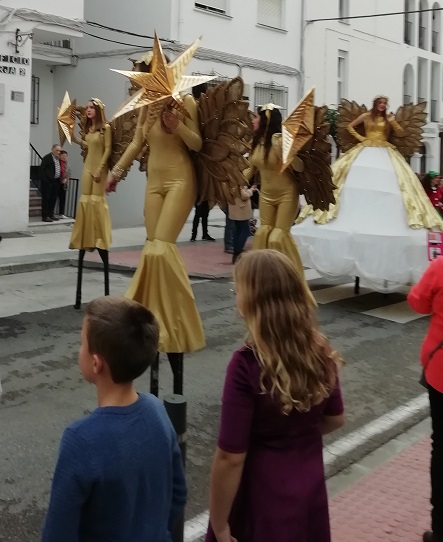
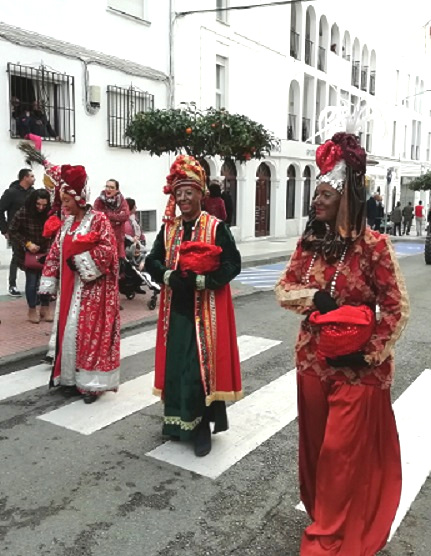
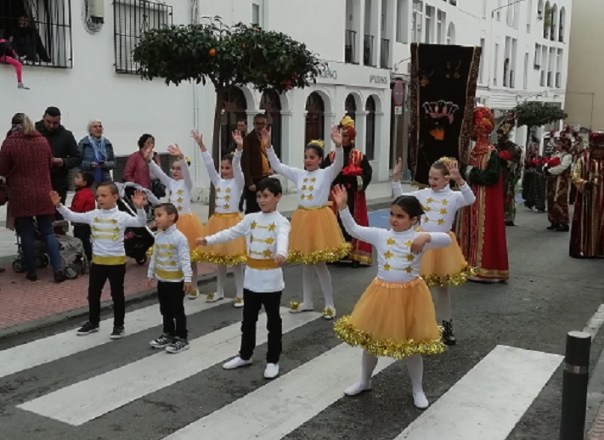
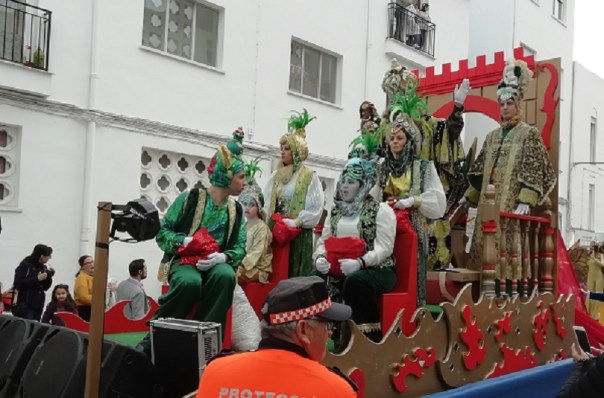 and as they set off on their journey around the town, we went to have dinner at the Bamboo Restaurant. We were just in time to catch the setting sun.
and as they set off on their journey around the town, we went to have dinner at the Bamboo Restaurant. We were just in time to catch the setting sun.

With dinner finished we then went along to the Balcon where the kings and their concubines were preparing to take part in the Christmas pageant.



0-0-0-0-0-0-0-0-0-0-0-0-0-0-0-0-0-0-0-0
Monday was my big day!

But we decided to take advantage of the sunshine and get out. So first I drove up into the hills to show my daughter and partner the view at Lake Viñuela. Then we climbed on up to another White Village at Alcaucin. We stopped alongside the Fuente de los Cinco Caños – The fountain of the five pipes.

This is believed to be of Arab origin and even during the longest periods of drought, the streams of water have never been known to dry up. The water is reputed to have health benefits so it’s common to see people arriving by car with half a dozen or so eight-litre containers to fill up and take home. There’s also a local legend that if an unattached man should drink from the centre pipe, he will marry a young lady from the village before the year is over. Maybe…………… but it never works for me! I left my visitors to stroll through the village, and meanwhile, I drove through the narrow streets to find a car park. Soon we met up and decided we were all feeling the chill. After all, we were at 1700 feet. We climbed aboard and headed for the beach at Torre del Mar and a late picnic lunch.
In the early evening, we returned to the apartment where I blew out the candles then opened some presents and cards. We rounded off a lovely day by driving to the Promenade at Torrox to have dinner at La Blanca Paloma.
0-0-0-0-0-0-0-0-0-0-0-0-0-0-0-0-0-0-0-0
The inevitable sad day on Tuesday. By ten o’clock I was at the apartment to load up luggage and passengers and drive to Malaga Airport. As usual, we left with enough time to make a short visit to Torremolinos Promenade for a stroll and a coffee before driving to the concourse for some sad farewells. Within the hour I was back at El Pino with jobs to do. So what’s first? Let’s start with the Christmas Lights. The festivities are over!
0-0-0-0-0-0-0-0-0-0-0-0-0-0-0-0-0-0-0-0
0-0-0-0-0-0-0-0-0-0-0-0-0-0-0-0-0-0-0-0
From the time my two daughters went home, it hasn’t been the best of times. They flew out at the beginning of the month to help me celebrate my birthday. No sooner had they gone than the weather went downhill, finally ending with Storm Gloria. The east coast suffered much worse than the southern shore, but we certainly had our share of rain. Malaga City also had a hail storm that left the streets buried for a short time under a 12-inch depth of ice. In our area, the period of poor weather culminated in thirty hours of continuous heavy rain with periods of thunder. But by Sunday morning, it was all over and the skies were blue again.
But bad news came on the same day. Our long-time friend Bob, had been taken into hospital on the Friday. Sadly, they weren’t able to save him.
Bob was a motor caravanner who was about twelve years into retirement. He used to pack up his van and leave the UK at the end of September and slowly make his way southwards, arriving at El Pino in October. He stayed until April, then made his way home again. He did that for several years before making the decision to stay here semi-permanently. He flew back to the UK periodically to attend his medical appointments. Last year, he told me he had just completed his residency application.
I first met him when he stopped at my awning, attracted by the aroma from my oven. A cake I’d been baking was almost finished.. We got chatting and it transpired that he had been a chef before retirement. He offered to demonstrate one of his specialties – a cheesecake. So the following week we set up our kitchen in Graham’s awning, and he gave a demonstration with a tasting the following day. This is Bob in happier times.

0-0-0-0-0-0-0-0-0-0-0-0-0-0-0-0-0-0-0
With the return of the good weather, on some afternoons I’ve been able to get out on the bike again. One of my favourite rides is along the valley road. It’s a road which leads nowhere but runs for a couple of miles up into the hills, before abruptly becoming dirt roads that follow the contours around the hillsides. The road was built fifteen or so years ago as part of a plan for new housing – but the financial crisis put a stop to it. In Spain, when a new development is planned, the first thing they build is the access roads – which here includes the pavements, street lighting, planting of the verges, parking lay-bys, roundabouts, road markings, and even pedestrian crossings. But not a house has ever been built, however, it makes a nice ride.
This is the view as I set off down the road.
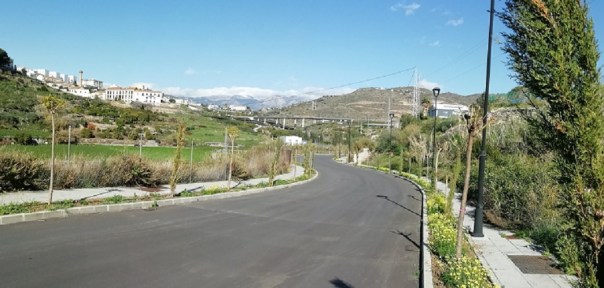
The field in the valley bottom is planted with potatoes grown under plastic. Soon they will be ready for harvesting. Above, on the tiered slopes, olive trees are growing. The attractive yellow plants growing in the verges are self-sown weeds. The white building on the left with the stark windows is the remains of an 18th Century sugar factory, one of several used to process the sugar cane which was once grown in the low lying areas close to the sea. Across the middle of the picture is the viaduct carrying the A7 motorway from one tunnel to the next. By the time I cycle under the motorway, the altitude has climbed another 300 feet.
0-0-0-0-0-0-0-0-0-0-0-0-0-0-0-0-0-0-0-0
At the weekend I thought it was time to have another day out. But where to go? Somewhere new! I looked at my maps and my eye was drawn eastwards towards the Alpujarras – the area on the southern slopes of Sierra Nevada. The village of Trevélez is reputed to be the highest village in Spain. I’ve often thought about going, but never have. I decided to give it a go.

The Alpujarra region consists of fifty-odd villages which around five hundred years ago became the last stronghold of the Spanish Muslims. After King Ferdinand captured Granada in 1492, the Muslims in southern Spain were forced to convert to Christianity. Those who refused took to the hills, settling in this remote and inaccessible area. But even then, they were hounded and eventually driven out of the country. King Phillip II induced 12000 Christian families to move from other parts of Spain to repopulate the villages. Two Muslim families in each village were allowed to stay. Their function being to educate the newcomers in the methods of living a mountain existence.
But back to my journey. The first part was the easy bit. Just a quick sprint along the motorway to Motril. There, I took the old road through the winding Guadalfeo Gorge. After a few miles, I’d reached the new Dam & Reservoir. I stopped and got out of the car and went across to stand in roughly the spot where my late wife and I stood more than twenty years ago. At the time we looked far down into the ravine where dozens of ant-like workmen were busily pouring concrete.
 Further up the valley, we could see roads, orchards, plantations, and farmsteads still being worked, and lived in. I remember thinking how sad that in just a couple of years time, several rivers and streams were going to carry the melted snow from the Sierras, down to the valley and flood their homes and wash away what was probably their life’s work. This is the scene today.
Further up the valley, we could see roads, orchards, plantations, and farmsteads still being worked, and lived in. I remember thinking how sad that in just a couple of years time, several rivers and streams were going to carry the melted snow from the Sierras, down to the valley and flood their homes and wash away what was probably their life’s work. This is the scene today.

And here is a picture taken around 20 years ago.

From this point, I left the comparatively straight roads and took to the twists and turns. As I drove, the dashboard altimeter increased and the temperature began to fall. Finally, as I drove into Trevélez, the dashboard showed that I’d reached 4760 feet at a chilly 7C – but lovely and sunny.
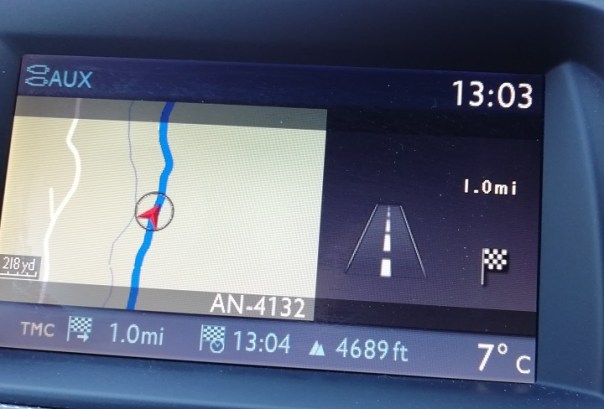
The town is built on the side of Mount Mulhacén and is part of the Sierra Nevada Nature Reserve. The main industry in the town is the production of jamón serrano – mountain ham. Fresh hams, having been trimmed and cleaned, are stacked and covered with salt for a couple of weeks to dry and preserve the meat. The salt is then washed off and the hams are hung up to dry for 6 to 18 months. The cold, dry atmosphere of the mountains provide ideal conditions. All along the main street are carniceros, delicatessens, and bars offering ham products.

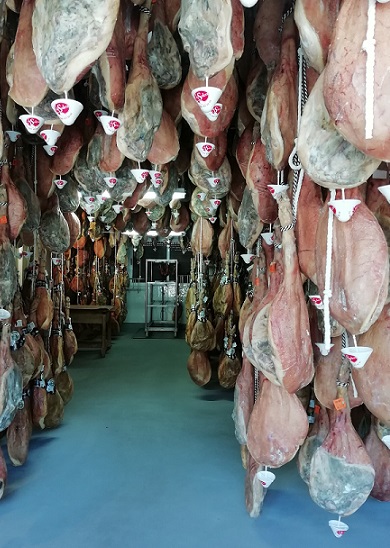
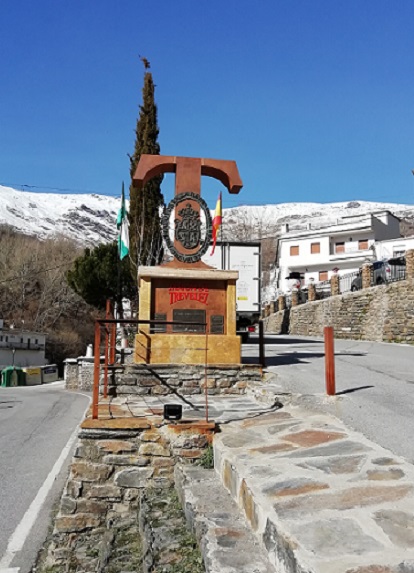


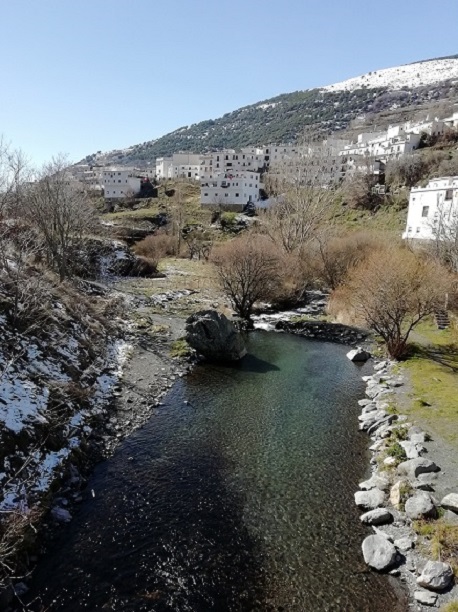

After a while, wandering the main street, looking in the shops, taking pictures and having lunch, it was time to think about the drive home. Several coaches were parked having brought visitors from Granada and Malaga. Since I hadn’t seen any coaches on my drive in, I presumed that the other road was perhaps better.
 I decided to take it. It was indeed wider but with some fearsome hair-pin bends.
I decided to take it. It was indeed wider but with some fearsome hair-pin bends.

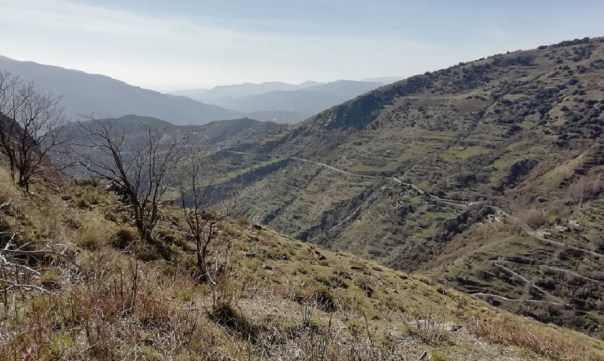

But eventually, I reached a point where I looked down on the Rules Reservoir again and knew that I’d almost reached the motorway.

0-0-0-0-0-0-0-0-0-0-0-0-0-0-0-0-0-0-0-0
The good weather was still with us so time for another day out. Looking at the maps, I chose a circular route through the mountains, parts of which I’ve done before and some that would be new ground. This was my route.

The drive began with seven miles in a westerly direction along the A7, before turning inland along the familiar valley bottom. Although I’ve already visited Viñuela three times this winter, I couldn’t resist pulling into the car park. I never tire of looking at this view.
 My route would continue up the mountains and through the Zafarraya Pass (which I’ve marked on the skyline with a tiny arrow). Here’s another view when I was a bit closer.
My route would continue up the mountains and through the Zafarraya Pass (which I’ve marked on the skyline with a tiny arrow). Here’s another view when I was a bit closer.
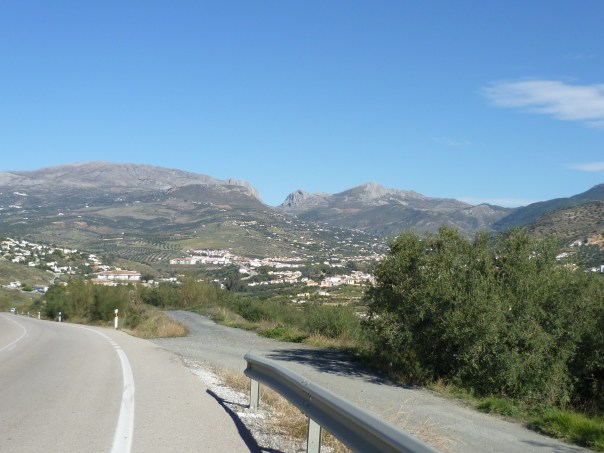
Half way up the mountain road I stopped to see the ruins of Castillo de Zalia.
 It’s believed that the Phoenicians may have built here first but the present ruin is all that’s left of the castle built by the Moors. They needed it to protect their ancient trade route between Granada and the Coast going through the Pass. The castle was captured by the armies of the Catholic Monarch in 1485. My drive continued up the twisting mountain road until finally, it reached the pass between the mountain ranges. I pulled into the small car park which is laid out alongside the bed of what was once a narrow-gauge railway line. My car’s dashboard indicated that I’d reached just a bit over 3000 feet. In 1922 a cog railway was built to carry passengers between here and the coast.
It’s believed that the Phoenicians may have built here first but the present ruin is all that’s left of the castle built by the Moors. They needed it to protect their ancient trade route between Granada and the Coast going through the Pass. The castle was captured by the armies of the Catholic Monarch in 1485. My drive continued up the twisting mountain road until finally, it reached the pass between the mountain ranges. I pulled into the small car park which is laid out alongside the bed of what was once a narrow-gauge railway line. My car’s dashboard indicated that I’d reached just a bit over 3000 feet. In 1922 a cog railway was built to carry passengers between here and the coast.

 The service closed in 1960. Now some of the old trackway makes a nice walk around the mountain side. Further along this track, but higher up the mountain is a cave. During excavations in 1979, archaeologists discovered inside the cave, parts of a skeleton. Subsequent radio carbon tests revealed the bones to be those of a Neanderthal man dating back 30000 years.
The service closed in 1960. Now some of the old trackway makes a nice walk around the mountain side. Further along this track, but higher up the mountain is a cave. During excavations in 1979, archaeologists discovered inside the cave, parts of a skeleton. Subsequent radio carbon tests revealed the bones to be those of a Neanderthal man dating back 30000 years.

Once through the pass the ground levels out and the road goes through the small town of Ventas de Zafarraya. On the far side of the town, the road takes a sharp turn right and continues straight and level for the next five miles. On either side of the road agricultural land stretches away to the distant mountains.
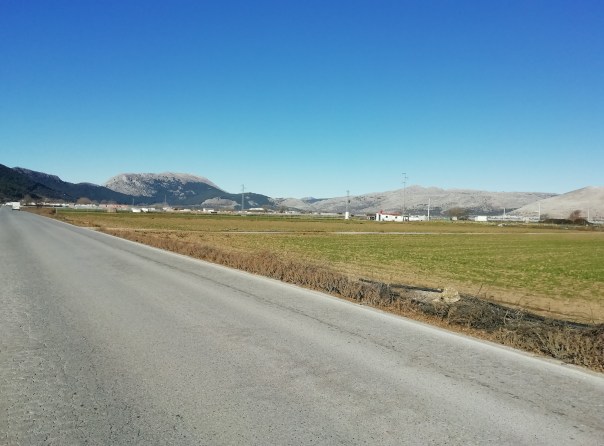 Then at the far end of the valley, the road climbs again until eventually, in the distance, are the snow-covered peaks of the Sierra Nevada some thirty or so miles away. Almond blossom which is now fully out is in abundance up here.
Then at the far end of the valley, the road climbs again until eventually, in the distance, are the snow-covered peaks of the Sierra Nevada some thirty or so miles away. Almond blossom which is now fully out is in abundance up here.


 The road begins to descend, giving a view of my next stop, the town of Alhama de Granada.
The road begins to descend, giving a view of my next stop, the town of Alhama de Granada.

 Although there’s evidence of Roman occupation, the town is very much of Arab origin with the houses built right up to the edge of the ravine. Down below in the bottom of the gorge are the ruins of flour mills.
Although there’s evidence of Roman occupation, the town is very much of Arab origin with the houses built right up to the edge of the ravine. Down below in the bottom of the gorge are the ruins of flour mills.

 Along the river, outside the town are the remains of the Arab baths. A modern hotel (always closed during the winter months) is built close to the water, which is at a constantly warm temperature and bubbles into a basin alongside the river. Even in February, there are usually one or two people bathing.
Along the river, outside the town are the remains of the Arab baths. A modern hotel (always closed during the winter months) is built close to the water, which is at a constantly warm temperature and bubbles into a basin alongside the river. Even in February, there are usually one or two people bathing.

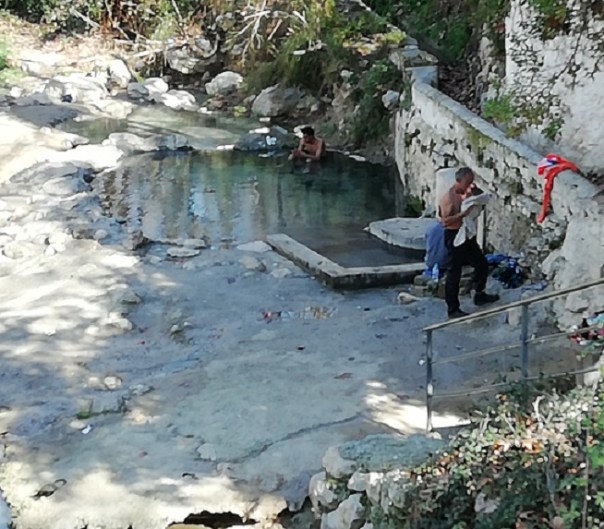

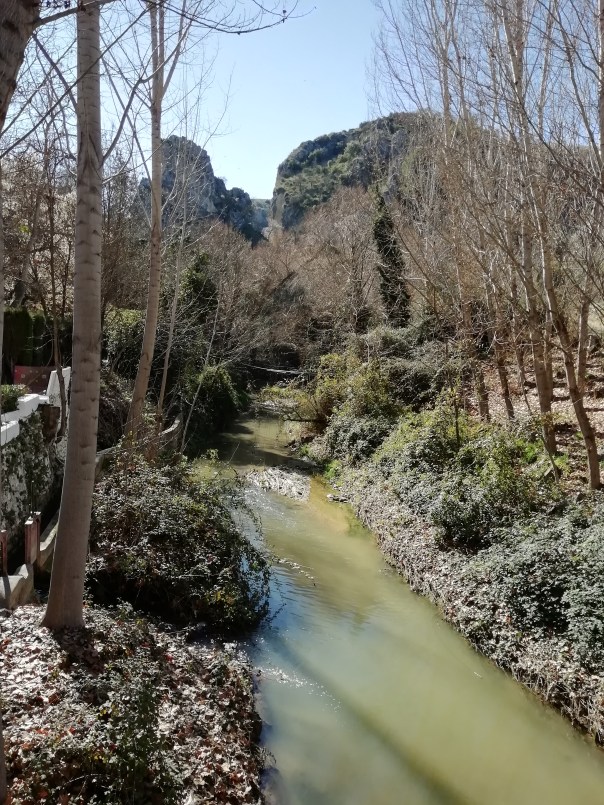
Back in the car, it was less than ten miles to my next stop at Embalse de los Bermejales. This is another man-made reservoir, surrounded by wonderful scenery.
 Just a short distance from the shoreline is a campsite – http://www.campinglosbermejales.com/camping/ It’s open all the year but virtually empty. Maybe that’s no surprise considering the remoteness and the access roads. It was also the spot from where I would be driving along unfamiliar roads. I set off on a road which for a time followed the shoreline of the reservoir, but before long it veered away and began to climb – and climb. Eventually, I arrived at a T-junction and saw I was at an altitude of 4430 feet. A good spot to stop and have a late lunch.
Just a short distance from the shoreline is a campsite – http://www.campinglosbermejales.com/camping/ It’s open all the year but virtually empty. Maybe that’s no surprise considering the remoteness and the access roads. It was also the spot from where I would be driving along unfamiliar roads. I set off on a road which for a time followed the shoreline of the reservoir, but before long it veered away and began to climb – and climb. Eventually, I arrived at a T-junction and saw I was at an altitude of 4430 feet. A good spot to stop and have a late lunch.
Back in the car again, the road meandered its way for the next 30 miles or so around the mountainsides. Fortunately, the number of cars I encountered could be counted on one hand, so I was able to make frequent stops to take in the wonderful mountain views.
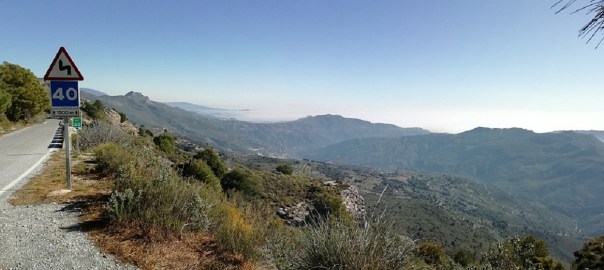


But eventually, the descent began and I reached the villages of Otivar, then Jete and soon afterwards, the drab outskirts of Almuñecar. I’d planned a further stop in the town to go in search of the Roman Aqueduct but I felt that I’d had enough for one day, so I joined the coast road and then the A7 which took me back to El Pino. I’d covered 110 miles.
0-0-0-0-0-0-0-0-0-0-0-0-0-0-0-0-0-0-0-0
Today’s destination would be a trip down memory lane. Even when Sheila and I went there some twenty-five years ago, the village was number one on the tourist trail. And seeing the number of coaches in the coach park, it undoubtedly still is. Where I was heading to, was the village of Mijas just inland from Torremolinos.
As I arrived, the first new thing I noticed was the multi-story car park, which like the village itself, is built into the hillside. And it’s huge. I drove to the entrance which is at the lowest level and took a ticket to raise the barrier. The parking bays are spread over no less than twelve floors however, lifts carry passengers either to the entry-level or to the twelfth floor which opens on to the Plaza de la Virgen de la Peña. As I came out of the lift on the top floor, ahead of me were the horse-drawn carriages waiting to take visitors on a tour of the town.
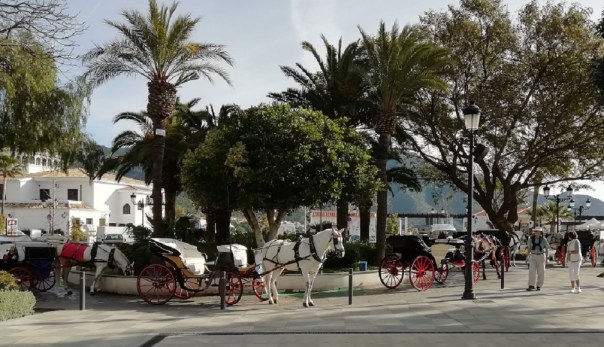
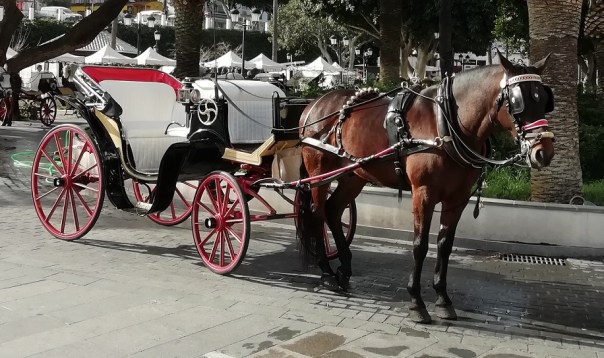 Over to my left was the rank of sleepy donkey taxis.
Over to my left was the rank of sleepy donkey taxis.
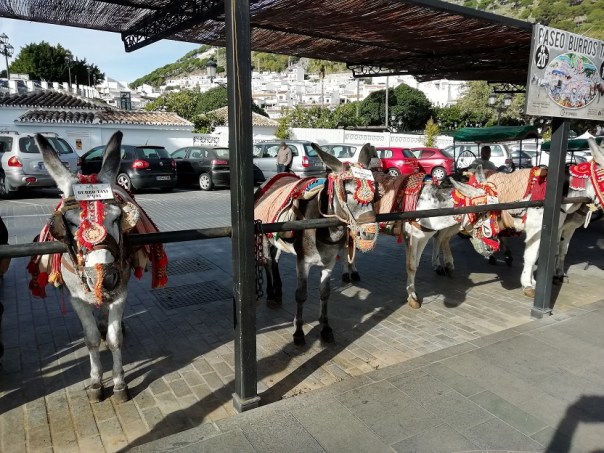 These Andalusian donkeys are native to the region and for centuries have been the transporters of goods and people between villages and harbours on the coast. Consequently, they are well adapted to working in high temperatures. In the 18th Century, they were forbidden by royal decree to be taken outside Andalusia and are now regarded as an endangered species. Their welfare and working conditions are closely monitored by the local authority. Continuing my walk, round to a rocky outcrop was La Ermita de la Virgen de la Peña. The hermitage is a small cave-like shrine said to have been excavated into the rock during the mid-1500s by a monk.
These Andalusian donkeys are native to the region and for centuries have been the transporters of goods and people between villages and harbours on the coast. Consequently, they are well adapted to working in high temperatures. In the 18th Century, they were forbidden by royal decree to be taken outside Andalusia and are now regarded as an endangered species. Their welfare and working conditions are closely monitored by the local authority. Continuing my walk, round to a rocky outcrop was La Ermita de la Virgen de la Peña. The hermitage is a small cave-like shrine said to have been excavated into the rock during the mid-1500s by a monk.
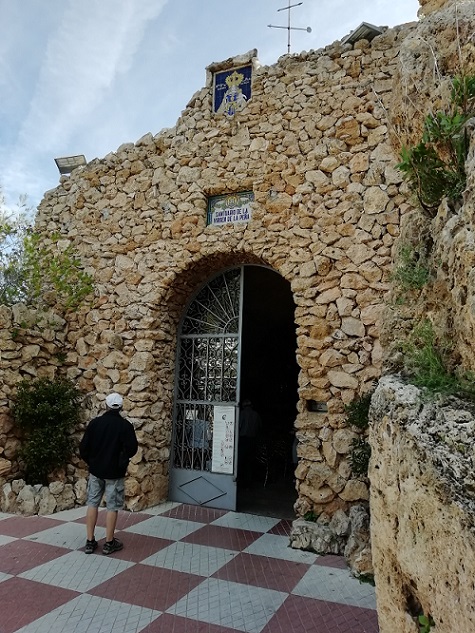
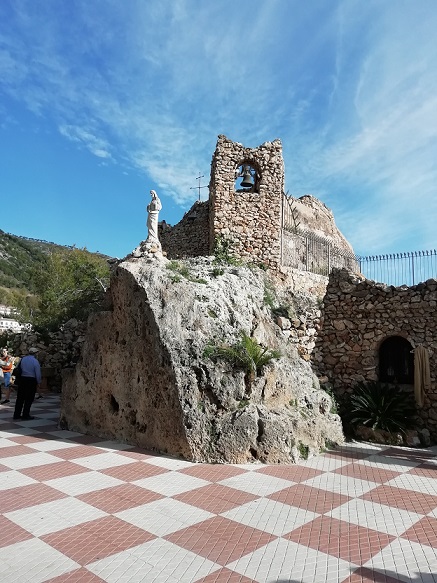
Inside there’s a small altar with several wrought iron benches. In an adjoining room are display cases containing ecclesiastical vestments and ornaments.
 By the 17th Century, a small monastery had been erected here. However, all traces of that have disappeared. From the balcony, at the end of the promontory, there are some lovely views down across the coastline.
By the 17th Century, a small monastery had been erected here. However, all traces of that have disappeared. From the balcony, at the end of the promontory, there are some lovely views down across the coastline.

From here, my walk took me uphill, through the village where nearly every establishment is a place to eat and drink, or to buy leather goods.


At the end of the road I entered another small plaza with more bars and restaurants, some of them occupying balconies above colonnaded walkways.

A narrow road, lined with raised gardens are decked out with bedding plants on one side and various cacti on the opposite side.
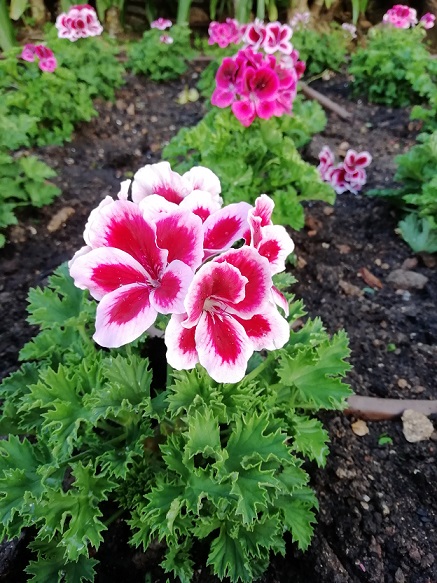
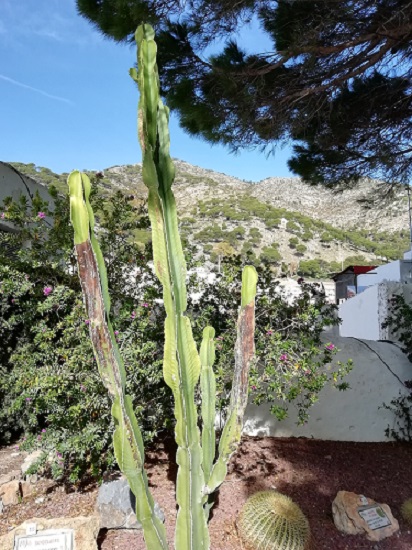
This road led me into the Plaza containing a small bull ring.
 I don’t share the Spanish enthusiasm for bull-fighting so I didn’t go into the arena but apparently, the rock formation forces the ring to be squashed to an oval with the seating arranged at the two ends. Beyond the bull ring lies the remains of what once was the castle.
I don’t share the Spanish enthusiasm for bull-fighting so I didn’t go into the arena but apparently, the rock formation forces the ring to be squashed to an oval with the seating arranged at the two ends. Beyond the bull ring lies the remains of what once was the castle.

As I continued my wander I came to a second hermitage built at the end of the 17th Century – the Ermita San Sebastián.
 There was a third one I hoped to visit, Ermita del Calvario, but when I saw its position………………………. Here it is in a picture
There was a third one I hoped to visit, Ermita del Calvario, but when I saw its position………………………. Here it is in a picture

It’s the tiny white smudge above the top of the lamp post. I felt that I’d walked enough for today so instead, I made my way back to the car park. And to my surprise! The cost of a day’s parking? One euro!
0-0-0-0-0-0-0-0-0-0-0-0-0-0-0-0-0-0-0-0
What I’ve been dreading arrived earlier in the week……………….Having to think about heading for home. I’d spent the morning cleaning then removing from the awning the oven, the microwave and all the furniture. Most of it went in the car but the microwave went on the floor in the end bathroom. It’s useful to have it there to use it on the journey home.
After lunch, I did what I do most days, I took a ride down the hill, along the main road to the prom,


picking up a few bits of shopping on the way back. It was sad to think that this was the last visit for this year. With the awning still to take down it was worrying to hear the rain pattering on the roof during the night, But it didn’t last long and it quickly dried as the sun came up. About half nine, Willy and Paul arrived to lend a hand with the taking down, cleaning and packing away of the awning. They are good neighbours and it was a relief to reach the stage where it was all done and we could open the lagers.
By 9.30 next morning, with the van turned, hitched on, lights checked and I was ready to start. Willy, Paul, Michael & Peggy came down to send me on my way and very soon I was heading east on the A7. This would be my route back to Bilbao.

After 75 miles I pulled in for a coffee break and to my dismay, discovered my off-side indicator on the van had stopped working. However, I managed without it and reached Santa Elena in time for a late lunch. Reception was closed and it took some time to find the owner, but finally I check-in and paid €18 for the night. I’ve stopped at this site several times over the years and I’ve written reviews in previous blog editions.
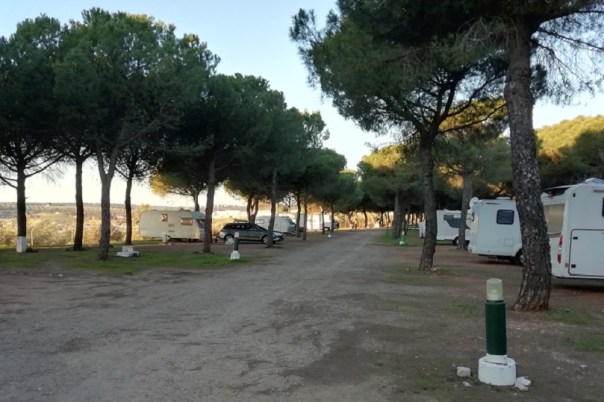
Briefly, the toilets and showers are very good, although toilet pans are lacking seats. Each plot has electric, water and wastewater disposal, however, the electric points are antiquated and in need of attention. The supply to each pitch is turned on at reception so if you inadvertently trip the breaker, getting the power restored could be difficult. Reception is rarely open and the owner is not readily available. To avoid any delay when I wanted to leave, I paid when I checked in, however, the following morning at 9.30, reception was closed, the barrier was down and the owner was not to be found. He appeared 10 minutes later having been off-site.
For six or seven years a new viaduct has carried traffic over the gorge, and to join the motorway requires a left turn from the site road and a drive through the village. A right-hand turn takes you on the drive through the gorge. Since I was in no great hurry, I decided to go that way. Without the nose to tail convoys of HGVs that once used the road, it’s become a lovely drive.
 After four or five miles I rejoined the motorway and did 100 miles before stopping to refuel and take a coffee break at N4/Km98. Back on the motorway, I didn’t stop again till I reached La Cabrera on the N1/Km57. To negotiate Madrid I left the N4 at Junction 17 to join the M50 and stayed on the M50 till the exit for Burgos/Junc. 21 of the N1.
After four or five miles I rejoined the motorway and did 100 miles before stopping to refuel and take a coffee break at N4/Km98. Back on the motorway, I didn’t stop again till I reached La Cabrera on the N1/Km57. To negotiate Madrid I left the N4 at Junction 17 to join the M50 and stayed on the M50 till the exit for Burgos/Junc. 21 of the N1.
I handed over my ACSI card and paid €20 for the one night. Only after check-in was I informed that the toilet block on the tourist section was closed for renovation. It was a long walk to the nearest block. I was able to pitch without unhitching. To reach Burgos I only had 100 miles to do, so there was no great hurry to leave. It also allowed the thick coating of ice to melt from the windscreen. Within five minutes, I was on the N1 and heading for Puerto de Sommosierra. It’s a five-mile climb to the top but a very well engineered three-lane motorway with only gentle curves. I didn’t stop until I reached Camping Fuentes Blancas at Burgos at around mid-day. Again, I presented my ACSI card but the guy rejected it, telling me it would be €2 cheaper if I booked in at the single person rate. That set me thinking – maybe I don’t need an ACSI card!


I don’t have to be at Bilbao till Monday evening, so I booked for two nights. I spent the afternoon first by changing the indicator bulb in the o/side rear light. That made no difference. A check on the pin at the socket showed no power when the car’s indicator was flashing. To investigate further will require the car to be unpacked – so I’ll have to manage till I’m home. Instead I took a walk along the outside of the site boundary fence and down to the river bank.

Next day I packed some lunch and a beer and set off in the car for Burgos. My first stop was on Castle hill. I parked quite close to the Castle entrance. In the 12th Century, during the Arab occupation, the hill had a palace and fort built on it As the town gradually increased in size, so did the walls surrounding the town. At the same time the Castle increased in size and the defences were made stronger. It was during the Peninsular War that the English army arrived here under the command of Lord Wellington who after his victories at Badajoz and Salamanca, thought to capture Burgos and drive away the invading French. Consequently he laid siege to the castle on the 19th September 1812 and after more than a month, had to face defeat and retreat back towards Portugal. A plaque close to the entrance commemorates the appalling loss of life on both sides. Nearly 2000 seriously wounded and more than 800 killed.

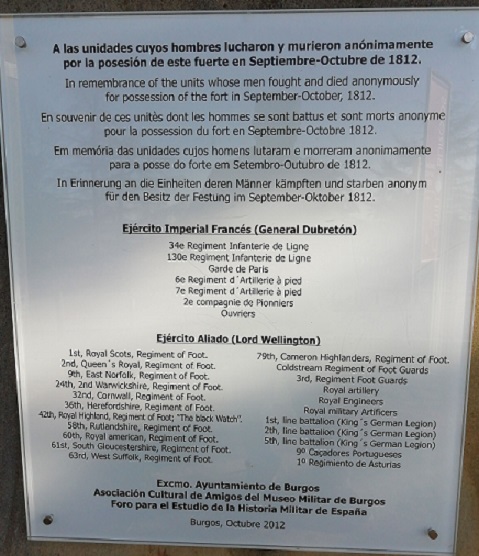

A bit further down the hill I stopped to look at one of the entrances through the medieval town wall. This is the San Esteban gate.
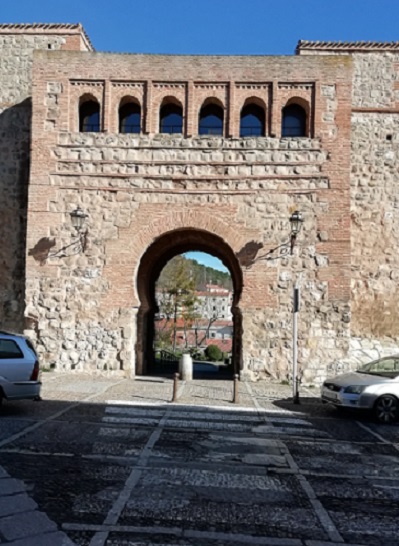
My next stop was to be at the Cathedral but finding a parking place proved impossible. Since, I’d visited the Cathedral two or three years ago, I gave up on the idea and moved on to my last port of call. The Cartuja de Miraflores.

Cartuja is the Spanish word for a religious house of Carthusian Order and Miraflores was the name given to a 14th Century royal hunting lodge which once stood on the site. Carthusian monks maintain a code of silence and live cut off from the outside world. Even family members are only expected to visit once each year. Their habit consists of a fawn hooded gown which ensures they only see what’s in front of them.
The monastery was founded in 1442 by King Juan II of Castile.
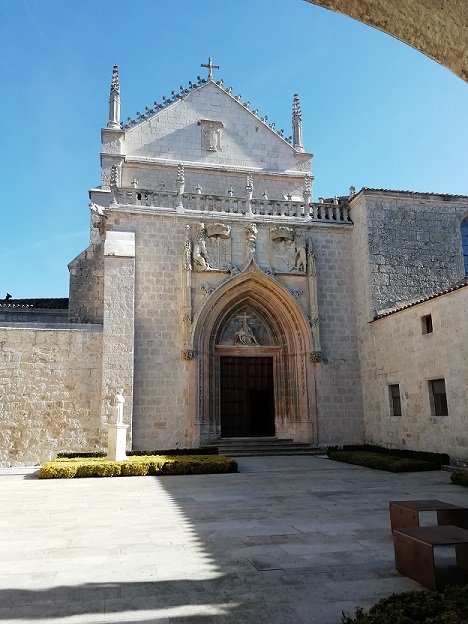

Once inside, the eye is drawn to the vaulting in the roof. Then to the stained glass. Unfortunately, it is so high up that it is impossible to fully appreciate. Apparently it was made in Flanders in the 15th Century. Whenever I visit an ancient religious house my interest always lies in the woodwork and carving. Here there is plenty. The forty choir stalls –
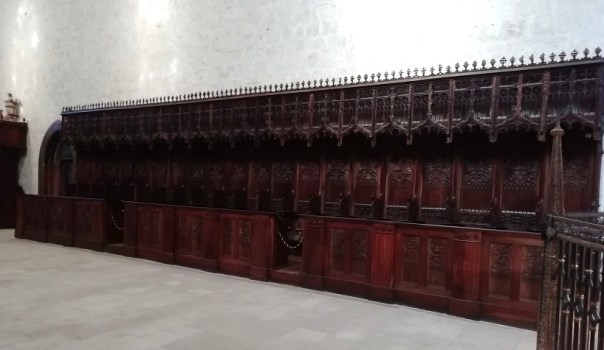
twenty on each side were carved from walnut in 1489 by a craftsman from Valladolid. Just beyond the choir stalls was a small door each panel depicting one of the evangelists.

Here is a closer view of just one panel.

Next I came across a book of chants which would have been laboriously written and decorated by hand . The style of musical notation is plainsong which is always written on a stave of four lines instead of the modern five.

Tomorrow is the final stage. The drive down to Bilbao.
0-0-0-0-0-0-0-0-0-0-0-0-0-0-0-0-0-0-0-0
I was in no great hurry to leave since it was only a drive of 110 miles, so I delayed leaving until 11 o’clock. Within a few miles I’d reached the AP1. The first thing I thing I noticed was the removal of the toll booths. On this stretch of motorway tolls charges ceased 18 months ago. The Spanish government’s policy is that once building costs have been recovered, the toll charges are removed. So, since my journey was done on the AP1 then the AP68, only the latter section was charged for. The toll charge was €10.25.
Before entering the dock area, I took the second exit just a short distance away to buy diesel. This filling station must sell the cheapest diesel in the whole of Spain. I paid €1.10 per litre. My previous fill-up on the A4 had cost me 1.28 per litre. Check-in had just opened as I arrived at the port, so I was booked in, given my windscreen label and cabin key and proceeded to the boarding lanes. This was the view at 4pm.
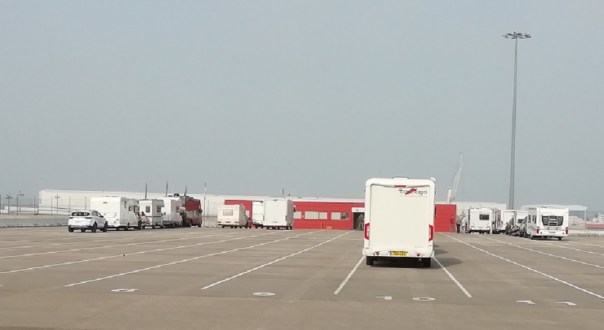 By the time check-in closes at 7pm no doubt there will be several more units joining me to spend the night on the dockside.
By the time check-in closes at 7pm no doubt there will be several more units joining me to spend the night on the dockside.
0-0-0-0-0-0-0-0-0-0-0-0-0-0-0-0-0-0-0-0
For whatever reason, I slept really well parked in the boarding lanes. I didn’t even hear the rain which had obviously fallen during the night. Cap Finistère arrived in Bilbao on time and unloading seemed to take forever. Eventually, I boarded and got parked on deck 5. My cabin was on deck 9 and I didn’t have too far to walk to the nearest lift. As I parked the outfit, a deck hand pulled on my caravan’s handbrake, at the same time swivelling his outstretched hand. I got his message!
We eventually left the berth about 30 minutes late. At first, moving about the ship could be done without difficulty, but by afternoon the sea had become rough so I kept to my cabin and watched a dvd. My bunk was aligned with the length of the ship and at times during the night, I thought I was going to be rolled onto the floor. Not until we were well up the Channel did the sea moderate. With the Isle of White coastline appearing on the beam, we knew we were nearly home. 
Shortly after The Victory came into view, the journey was over.
Because of the reduction in speed during the night, instead of arriving in Portsmouth at 9.15, we arrived at 12.30.
Border Control at Portsmouth has become a nightmare. Of the eight available lanes, only three were open. Each vehicle driver hands over their passport(s). They are scanned, then the pictures compared with the occupants of the vehicle. Then the Officer leaves his cabin and proceeds to examine the interior of the caravan or motor van. As most vehicles consist of a motor van or caravan with several outside lockers which are all examined, the inspections take forever. Although the ship docked at 12.30, as I joined the motorway outside the dockyard, the time was 2.45. That’s two hours and 15 minutes to embark and pass through Border Control. Ninety minutes later I was home.
0-0-0-0-0-0-0-0-0-0-0-0-0-0-0-0-0-0-0-0
As I’ve done in previous years, this is a list of my travel expenses.
It does not include shopping or entertainment expenses. It does include site electricity and heating costs.
Expenses
Ferry fare Outward £323
Homeward £340
Total ferry fare which included friends discount £663
Fuel for both directions £295
Toll on the A68 to Bilbao €10.25
Site fees for 2.5 months €800
Site fees for 7 nights outward journey €140
Site fees for 4 nights homeward journey €74
Total site fees €1014 Approx conversion £862
Red Pennant for 94 days £786
Total £2615
Note: This year’s total is less than last year. However, my stay is usually 122 days duration. This year was only 94 days.




